
SPRING 2023 HISTORYNET.COM ACWP-230400-COVER-DIGITAL.indd 1 12/9/22 2:05 PM




















































































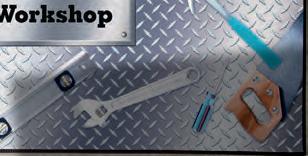




OFFER
Super
Hammers have
. Here’s
they
$21.99 Personalized Garage Mats Grease Monkey or Toolman, your guy (or gal) will love this practical way to identify personal space. 23x57"W. Tools 808724 Tires 816756 $45.99 each Personalized Extendable Flashlight Tool Light tight dark spaces; pick up metal objects. Magnetic 6¾" LED flashlight extends to 22"L; bends to direct light. With 4 LR44 batteries. 817098 $31.99 Personalized 6-in-1 Pen Convenient “micro-mini toolbox” contains ruler, pen, level, stylus, plus flat and Phillips screwdrivers. Giftable box included. Aluminum; 6"L. 817970 $29.99 ACWP-230117-004 Lillian Vernon LHP.indd 1 11/23/22 12:55 PM
Personalized
Sturdy Hammer
a way of walking o
one
can call their own. Hickory-wood handle. 16 oz., 13"L. 816350
Personalized 13-in-1 Multi-Function Tool




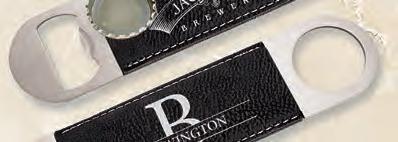





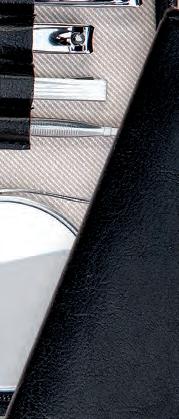


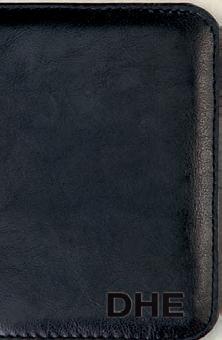
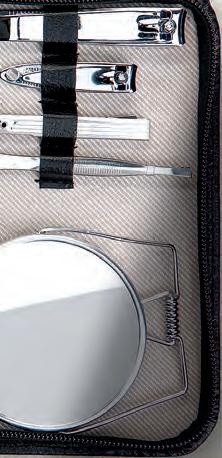














Our durable
Vernon products are built
and manufacturing
or monogram. Ordering
free.*
*FREE SHIPPING ON ORDERS OVER $50. USE PROMO CODE: HISACW S3 LILLIANVERNON.COM/ACW The Personalization Experts Since 1951 OFFER EXPIRES 4/30/23. ONLY ONE PROMO CODE PER ORDER. OFFERS CANNOT BE COMBINED. OFFER APPLIES TO STANDARD SHIPPING ONLY. ALL ORDERS ARE ASSESSED A CARE & PACKAGING FEE. RUGGED ACCESSORIES FOR THE NEVER-ENOUGH-GADGETS GUY. JUST INITIAL HERE. Personalized Bottle Opener
tool
day with
cool brew.
$11.99 each
Personalized Grooming Kit Indispensable zippered manmade-leather case contains comb, nail tools, mirror, lint brush, shaver, toothbrush, bottle opener. Lined; 5½x7". 817548 $29.99
Lillian
to last. Each is crafted using the best materials
methods. Best of all, we’ll personalize them with your good name
is easy. Shipping is
Go to LillianVernon.com or call 1-800-545-5426.
Handsome
helps top o a long
a
1½x7"W. Brewery 817820 Initial Family Name 817822
Personalized Beer Caddy Cooler Tote Soft-sided, waxed-cotton canvas cooler tote with removable divider includes an integrated opener, adjustable shoulder strap, and secures 6 bottles. 9x5½x6¾". 817006 $64.99
ACWP-230117-004 Lillian Vernon RHP.indd 1 11/23/22 12:58 PM
All the essential tools he needs to tackle any job. Includes bottle opener, flathead screwdriver, Phillips screwdriver, key ring, scissors, LED light, corkscrew, saw, knife, can opener, nail file, nail cleaner and needle. Includes LR621 batteries. Stainless steel. 818456 $29.99

Spring 2023 2 AMERICA’S CIVIL WAR CLOCKWISE FROM LEFT: HARPER’S WEEKLY; STATE LIBRARY AND ARCHIVES OF FLORIDA; BATTLES AND LEADERS OF THE CIVIL WAR; LIBRARY OF CONGRESS; COVER: LIBRARY OF CONGRESS/PHOTO ILLUSTRATION BY BRIAN WALKER 22 Loose Lips Ambrose Burnside’s three-front war in North Carolina By Bruce Allardice ACWP-230400-CONTENTS.indd 2 12/13/22 8:44 AM
By Sheritta Bitikofer



SPRING 2023 3 Departments 6 L ETTERS An unresolved mystery; deserving credit for VMI’s other cadets 8 G RAPESHOT! Mapping faces of the war; Louisiana side hustle 12 REGIMENTAL PRIDE That time the 8th Vermont refused to back down 1 6 L IFE & LIMB State-of-the-art solution for wounded soldiers 18 FROM THE CROSSROADS Gettysburg memories yield a lesson in humility 20 SOUTHERN ACCENT The tables were turned three decades before the war 54 TRAI LSIDE Parker’s Crossroads, Tenn.: Forrest rides roughshod again 58 5 QUESTIONS Shining new light on a troubled Johnston–Davis alliance 60 R EVIEWS As the war wanes, Lincoln finds some divine guidance 64 FI NAL BIVOUAC Oh, the Humanity! ON THE COVER: MAJ. GEN. AMBROSE BURNSIDE, PHOTOGRAPHED BY MATHEW BRADY IN JUNE 1864. AS COMMANDER OF THE 9TH CORPS, BURNSIDE HAD RETURNED TO THE ARMY OF THE POTOMAC AND THE FIGHTING IN VIRGINIA IN MAY 1864 DURING LT. GEN. ULYSSES S. GRANT’S ADVANCE ON RICHMOND. New! New! Illustrator of the Confederacy William Sheppard’s pad and pencil revealed an unexplored side of the war
30 46 Unfinished Business After Cedar Creek, Sheridan’s men were sure they hadn’t seen the last of Jubal Early’s battered army
A. Noyalas Sunshine State Showdown An unexpected Confederate victory at Natural Bridge offered a little of everything
By Stephen Davis
By Jonathan
38 ACWP-230400-CONTENTS.indd 3 12/13/22 8:44 AM
Canadian GST No. 821371408RT0001 The contents of this magazine may not be reproduced in whole or in part without the written consent of HISTORYNET, LLC. PROUDLY MADE IN THE USA






Publisher
BOARD Gordon Berg, Jim Burgess, Steve Davis, Richard H. Holloway, D. Scott Hartwig, Larry Hewitt, John Hoptak, Robert K. Krick, Ethan S. Rafuse, Ron Soodalter, Tim Rowland C ORPORATE Kelly Facer SVP Revenue Operations Matt Gross VP Digital Initiatives Rob Wilkins Director of Partnership Marketing Jamie Elliott Senior Director, Production Mel Gray Print Production Coordinator ADVERTISING Morton Greenberg SVP Advertising Sales mgreenberg@mco.com Terry Jenkins Regional Sales Manager tjenkins@historynet.com DIRECT RESPONSE ADVERTISING MEDIA PEOPLE Nancy Forman nforman@mediapeople.com ©2023 HISTORYNET, LLC Subscription Information: 800-435-0715 or shop.historynet.com List Rental Inquiries: Belkys Reyes, Lake Group Media, Inc., 914-925-2406; belkys.reyes@lakegroupmedia.com America’s Civil War (ISSN 1046-2899) is published quarterly by HISTORYNET, LLC, 901 North Glebe Road, Fifth Floor, Arlington, VA 22203 Periodical postage paid at Vienna, VA, and additional mailing offices. Postmaster, send address changes to America’s Civil War, P.O. Box 900, Lincolnshire, IL 60069-0900 Canada Publications Mail Agreement No. 41342519
Michael A. Reinstein Chairman &
Vol. 36, No. 1 Spring 2023 ADVISORY
Chris K. Howland Editor Jerry Morelock Senior Editor
Brian Walker Group Design Director Melissa A. Winn Director of Photography Austin Stahl Associate Design Director
4 AMERICA’S CIVIL WAR LIBRARY OF CONGRESS/PHOTO ILLUSTRATION BY
Sign up for our FREE weekly e-newsletter at:
HISTORYNET VISIT HISTORYNET.COM PLUS! Today in History What happened today, yesterday— or any day you care to search. Daily Quiz Test your historical acumen—every day! What If? Consider the fallout of historical events had they gone the ‘other’ way. Weapons & Gear The gadgetry of war—new and old— effective, and not-so effective. Confederate
was a rip-roaring, knock-kneed
his fondness for alcohol made him his own
Whiskey-Fueled Warrior TRENDING NOW ACWP-230400-MASTHEAD.indd 4 12/12/22 9:22 AM
Dana B. Shoaf Editor in Chief Claire Barrett News and Social Editor
BRIAN WALKER
historynet.com/newsletters
officer Nathan “Shanks” Evans
fighter—and
worst enemy. By Rick Britton historynet.com/shanks-evans-civil-war
When 1982 rolled around, the U.S. Mint hadn’t produced a commemorative half dollar for nearly three decades. So, to celebrate George Washington’s 250th birthday, the tradition was revived. The Mint struck 90% silver half dollars in both Brilliant Uncirculated (BU) and Proof condition. These milestone Washington coins represented the first-ever modern U.S. commemoratives, and today are still the only modern commemorative half dollars struck in 90% silver!





Iconic Designs of the Father of Our Country


These spectacular coins feature our first President and the Father of Our Country regally astride a horse on the front, while the back design shows Washington’s home at Mount Vernon. Here’s your chance to get both versions of the coin in one remarkable, 40-year-old, 2-Pc. Set—a gleaming Proof version with frosted details rising over mirrored fields struck at the San Francisco Mint, and a dazzling Brilliant Uncirculated coin with crisp details struck at the Denver Mint. Or you can get either coin individually.
Very Limited. Sold Out at the Mint!



No collection of modern U.S. coins is complete without these first-ever, one-year-only Silver Half Dollars—which effectively sold out at the mint since all unsold coins were


melted down. Don’t miss out on adding this pair of coveted firsts, each struck in 90% fine silver, to your collection! Call to secure yours now. Don’t miss out. Call right now!

1982 George Washington Silver Half Dollars GOOD — Uncirculated Minted in Denver 2,210,458 struck Just $29.95 ea. +s/h Sold Elsewhere for $43—SAVE $13.05
BETTER — Proof Minted in San Francisco 4,894,044 struck Just $29.95 ea. +s/h Sold Elsewhere for $44.50—SAVE $14.55












BEST — Buy Both and Save! 2-Pc. Set (Proof and BU) Just $49.95/set SAVE $9.95 off the individual prices Set sold elsewhere for $87.50—SAVE $37.55
FREE SHIPPING on $49 or More! Limited time only. Product total over $49 before taxes (if any). Standard domestic shipping only. Not valid on previous purchases.
1-800-517-6468 Offer
GWH132-01 Please mention this code when
Code
you call.
coin and currency issues
government. The collectible coin market is unregulated, highly speculative and involves risk. GovMint.com reserves the right to decline to consummate any sale, within its discretion, including due to pricing errors. Prices, facts, figures and populations deemed accurate as of the date of publication but may change significantly over time. All purchases are expressly conditioned upon your acceptance of GovMint.com’s Terms and Conditions (www.govmint.com/terms-conditions or call 1-800-721-0320); to decline, return your purchase pursuant to GovMint.com’s Return Policy. © 2022 GovMint.com. All rights reserved. GovMint.com • 1300 Corporate Center Curve, Dept. GWH132-01, Eagan, MN 55121 A+ To learn more, call now. First call, first served! FIRST and ONLY Modern Commemorative Struck in 90% Silver! BRILLIANT UNCIRCULATED -Crisp, Uncirculated Finish -Struck at the Denver Mint -Sold Out Limited Edition PROOF -Exquisite Proof Finish -Struck at the San Francisco Mint -Sold Out Limited Edition George Washington Reverse: Mount Vernon & Heraldic Eagle First in War, First in Peace, First on a Modern Commemorative Coin! SPECIAL CALL-IN ONLY OFFER Actual size is 30.6 mm ACWP-230117-003 GovMint 1982 George Washington Half Dollar.indd 1 11/23/22 12:48 PM
GovMint.com® is a retail distributor of
and is not affiliated with the U.S.
Shared quest
I enjoyed John Banks’ “Who Are They?” article in the Autumn issue [P.30], especially the mention of two photographs in the collection of the former Museum of the Confederacy. I was president of the MOC from 2004 until its combination with another museum to become the American Civil War Museum, where I was co-CEO until my retirement at the end of 2019.
We did indeed have fun with “Whose Little Girl Is This?” in 2012. That Associated Press article appeared in more than 500 newspapers around the world, and we got some “interesting” inquiries.
A woman from California claimed that she could speak with the dead. If we would only fly her to Richmond, she would have a séance and ask the little girl to identify herself.
Another man, also from California (aka the land of fruits and nuts), called to say that he knew the little girl because she was the ghost who haunted his house.
We got a great lead from another woman who contacted us. She was a retired photograph curator at the Smithsonian. While she had no idea about the little girl, she actually recognized the furniture and setting as from a studio in Vermont. We saw other images from that studio and believe she was correct. But, dang, there were no Vermont regiments involved at Port Republic (or nearby Cross Keys), so the mystery was not solved.
S.
Waite Rawls III Richmond, Va.
New Market Fan
I still remember my first trip to New Market about 25 years ago. I stopped there without any real expectations on my way home to Hagerstown from Roanoke. Never really thought of
Somebody’s Girl
The identity of the little girl pictured in this ornate case found on a Civil War battlefield remains a mystery some 160 years later.

myself as a Civil War person at the time, but I was curious as I drove by.
I had never heard before about the VMI Cadets who fought there, but after walking the battlefield and visiting the museum, I definitely wanted to learn more about them. I kept trying to wrap my head around what they must have been thinking and the bravery they showed in making that charge across that muddy field against those Union guns. It also made me want to learn more about the war in general.
Unfortunately, I’ve only been able to get back to New Market a few times since, so I was happy to see the article you had about the battle in the Autumn
issue (“Mowed Down Like Grass,” P.38). I never realized what the other VMI boys did on the other side of the battlefield. So it’s nice to see them finally get some credit.
I also love the painting by Keith Rocco shown in the article. We’re lucky the Civil War world has a lot of great artists like him out there.
Pete Falcone
Wilmington, Del.
Last Resort (cont’d)
I wanted to respectfully write in response to Tom Desjardin’s article about the 20th Maine at Gettysburg (“The Last Resort?”–Autumn 2022). Dr. Desjardin writes: “Apart from several dozen transfers from the disbanded 2nd Maine Infantry, Gettysburg was what one veteran called the 20th’s “first real, standup fight,” and later notes that Chamberlain’s “lack of combat leadership experience” surely would have
6 AMERICA’S CIVIL WAR
COURTESY OF THE MAINE HISTORICAL SOCIETY VIRGINIA MUSEUM OF HISTORY AND CULTURE
LETTERS
ACWP-230400-LETTERS.indd 6 12/12/22 9:23 AM
granted him “a misstep or two.”
It’s important to note that the 20th Maine had been in combat prior to Gettysburg. They fought at Shepherdstown Ford on September 19, 1862, firing at Confederate positions on the other side of the river, and taking three casualties. Most notably, they fought at Marye’s Heights at Fredericksburg, with four men killed in action and 32 wounded, after which they were held in place for nearly two days. Their men had to hunker down behind dead bodies to find cover, and temperatures at night were below freezing. This was not as involved an action as other regiments; a frontal attack was aborted, and the regiment engaged the enemy from long range.
The months and weeks before and after that battle, however, involved actions to guard telegraph lines, fords, and also being held in reserve during major actions like Antietam.
It would be inaccurate to portray the 20th Maine as inexperienced troops. They had suffered many losses due to illness (more than 300), had fought in combat before, and had been serving together in different capacities for nearly a year.
I can see Dr. Desjardin’s point that they were not “experienced” or “crack troops.” But he clearly states that aside from the 2nd Maine transfers, they hadn’t seen action. There is no mention of the 20th Maine’s participation in two other major campaigns that included combat.
This all being said, I believe that Mr. Desjardin wrote an excellent and true article, highlighting the fact that the Confederate forces lacked the manpower to threaten the Union left flank at Gettysburg. It was illuminating, to say the least, and is a great analysis of what happened.
Justin Tkachuk Via E-mail
Tom Desjardin responds: While the 20th Maine experienced brief moments of combat and one prolonged engagement in the midst of a major battle,
History Made Here
Chamberlain and 20th Maine veterans, accompanied by various family members, pose by their Little Round Top monument in 1888.

Gettysburg was different in many ways—especially in the style of fighting, which those men had yet to see for any sustained period. Standing, loading, and firing while bullets whizzed by and comrades around them fell was the true test of unit effectiveness. The 20th Maine had not been thus tested before July 2, 1863.
Captain Lyman Prince read the regimental history at the dedication of its three monuments at Gettysburg. It is reprinted in full in the 20th’s section of the book Maine at Gettysburg. In it, he said: “But for the men of the 20th this was the first real stand up fight. They were under fire to be sure at Shepherdstown; they made a gallant advance at Fredericksburg, showing the stuff that was in them, but their losses were light in spite of their hazardous position; and the running fight at Aldie [Va.] was more trying to the legs and wind than the courage.”
At Shepherdstown, the unit marched up the steep bank on the enemy side and fired only briefly before being driven back down the bank, across the river, and into the safety of an empty canal on the Union side. At Fredericksburg, they had but one real maneuver
to perform just as they left the city and started up the long slope that led to Marye’s Heights. Here, part of the regiment encountered a rail fence lying straight across their path.
The soldier’s descriptions of the confusion and misdirection caused by this obstacle demonstrated their still underdeveloped skills at maneuvering under fire. Near the top of the heights, they moved in good order to replace another unit, then marched down the next night, then repeated the whole exercise the following day, but they never stood in line and traded bullets with the enemy.
Of the 41 casualties, four were killed outright and two mortally wounded, although one of those died of tetanus and not the wound itself. The casualty lists include an unusually high number of wounds by shell fragments, indicating they were hit from a distance, rather than by the enemy “standing up” in front of them.
What Captain Lyman seems to have meant is that, before Gettysburg, the unit had never stood in line of battle and exchanged fire with an enemy unit doing the same directly opposite them. This is a test of nerve and courage and often used as the best measure of a unit in years afterward.
WRITE TO US
E-mail: acwletters@historynet.com Letters may be edited.
@AmericasCivilWar @ACWmag
SPRING 2023 7
LETTERS
COURTESY OF THE MAINE HISTORICAL SOCIETY VIRGINIA MUSEUM OF HISTORY AND CULTURE
ACWP-230400-LETTERS.indd 7 12/12/22 9:23 AM
A Blast of Civil War Stories

Faces of the Civil War

DIGITAL MAP SHARES POPULAR PHOTOS IN THEIR CONTEXT
The Library of Congress in November debuted an online exhibit mapping hundreds of portrait photographs from the Liljenquist Collection to events of the Civil War, including images of soldiers linked to the battles where they fought and died. The interactive map encompasses more than 100 battles, from Gettysburg and Antietam to lesser-known skirmishes. The faces of nurses are connected to the sites where they cared for the wounded. Prisoners of war are associated with the camps that confined them.



Some of the portraits are mapped to more than one location, if, for example, the person was present at more than one battle. Likewise, there might be more than one portrait of the same person mapped at a location if multiple photographs of them exist in the collection.

The Liljenquist Collection at the Library of Congress features more than 3,000 portrait photographs, including ambrotypes and tintypes, and small card photos known as cartes-de-visite of the men and women who served during the war for both the Union and
Confederacy. Among those represented are African Americans, sailors, nurses, veterans, and soldiers posed with family members.
The Liljenquist family began donating its collection to the Library of Congress’ Prints & Photographs Division in 2010 with an initial gift of more than 700 ambrotypes and tintypes. Since then, Liljenquist and his three sons—Jason, Brandon, and Christian—have continued to build the collection to include albumen photographs and cartesde-visite, manuscripts, patriotic envelopes, letters, and artifacts related to the Civil War.

Photo Collage
The Liljenquist Collection includes more than 3,000 portrait photographs, a mix of soldiers and civilians who served during the Civil War.
The interactive map allows users to zoom in to view locations in more detail and click to see associated portraits. Locations on the map show places where people in the images were and not where the photographs were taken, in most instances. For more information about each photograph, users can click on the thumbnail image to view details about the item. To view the map, visit: bit.ly/ LiljenquistMap —Melissa A. Winn
COURTESY OF ALBERT R. LABURE; LIBRARY OF CONGRESS 8 AMERICA’S CIVIL WAR LIBRARY OF CONGRESS (5)
GRAPESHOT! ACWP-230400-GRAPESHOT.indd 8 12/13/22 8:46 AM
Luck of the Draw
Former Confederate Brig. Gen. Francis R.T. Nicholls’ ascension to governor of Louisiana in 1888—his second, non-consecutive term in Baton Rouge—spelled the eventual death knell of the corrupt Louisiana Lottery Company. The end of that enterprise, however, also cut short an extremely lucrative deal for two other former notable generals in gray: P.G.T. Beauregard and Jubal Early.
To be clear, Beauregard and Early were not part of the company’s notorious criminal endeavors. Their role was simply to be present when the lottery tickets were drawn, with both paid a princely sum of $20,000 per year (equivalent to $200,000 today) for the task.

When founded in 1868, the company was given free rein by state legislators to conduct monthly lotteries for the next 25 years. It was at the time the nation’s only legal lottery system, guaranteeing a hefty profit for company officials.
Nicholls suffered three catastrophic combat wounds during the Civil War, losing an eye, a leg, and his left arm. His innovative campaign slogan while running for governor was: “All that is left of him is right.” Once elected, he quickly strove to rid Louisiana of the fraudulent venture, although that ultimately occurred during the term of his successor, Murphy J. Foster.
Shown above are the front and back sides of an LLC lottery ticket, signed by both Beauregard and Early. Albert R. LaBure
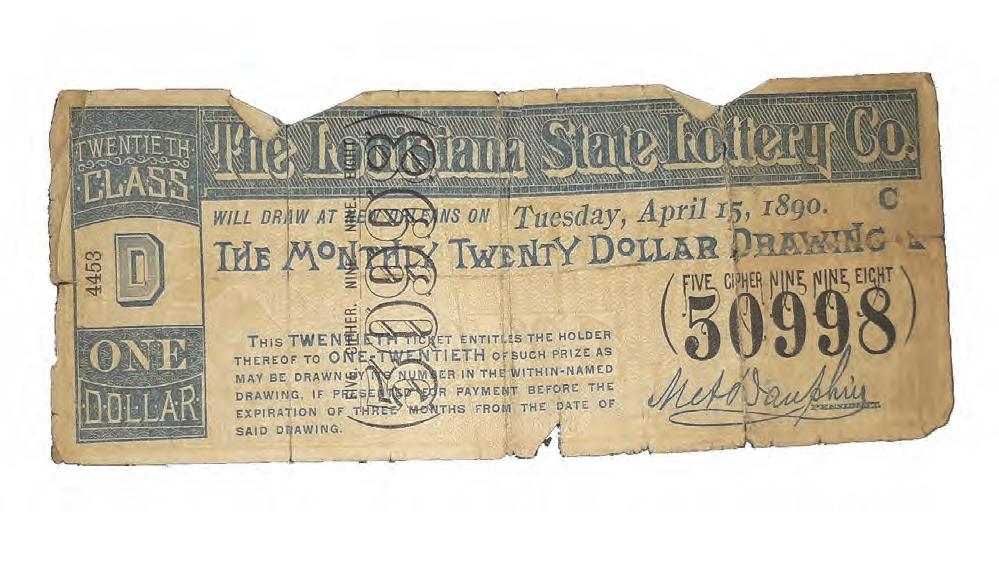

SPRING 2023 9 COURTESY OF ALBERT R. LABURE; LIBRARY OF CONGRESS LIBRARY OF CONGRESS (5)
QUIZ
Answers: A.7, B.9, C.5, D.1, E.10, F.6, G.4, H.8, I.3, J.2
Factor Match the officer with the battle (example: Phil Sheridan and Cedar Creek) to whose outcome he extensively contributed— positively or negatively. A. Ambrose Powell Hill (+) B. George H. Thomas (+) C. Manuel Chaves (+) D. Don Carlos Buell (–) E. Franz Sigel (–) F. John Bell Hood (–) G. Charles Zagonyi (+) H. John B. Magruder (+) I. Lew Wallace (+) J. David G. Farragut (+) 1. Perryville, 1862 2. New Orleans, 1862 3. Monocacy, 1864 4. Springfield, 1861 5. Glorieta Pass, 1862 6. Franklin, 1864 7. Antietam, 1862 8. Galveston, 1863 9. Chickamauga, 1863 10. New Market, 1864
George H. Thomas
The Human
CONVERSATION
ACWP-230400-GRAPESHOT.indd 9 12/13/22 8:46 AM
PIECE
Never Forget
Standing for Now
The NAACP reportedly has threatened to sue should there be a transfer of the property and its memorial, which was erected in 1912.
Officials in Virginia’s Mathews County have come up with a novel approach to keep one of its Confederate monuments standing for the foreseeable future. According to the Gloucester-Mathews Gazette-Journal, the county’s board of supervisors had prepared a quitclaim deed that, if approved, will hand possession of the monument and the plot of land upon which it stands to the Mathews War Memorial Preservation Inc., created by David M. “Sonny” Fauver, a member of the Lane Armistead Camp of the Sons of Confederate Veterans. The plot, adjoining the county courthouse, measures 80.97 square feet.


The Gazette-Journal reported that the deed stipulates the corporation is responsible at all times for maintaining the property and monument in an “appropriate” manner, and does not allow the placement of any flag or banner on the ground there other than the U.S. flag or those of the Commonwealth of Virginia or Mathews County.
CIVIL WAR ILLUSTRATED
At the onset of the Civil War, newspapers North and South alike often used humorous illustrations to lighten the collective mood of their readers. This cartoon was created before the war’s first major battle at Manassas, Va. It shrewdly portrays what veteran officers usually encountered when commanding volunteer soldiers with previous experience holding weapons only for hunting wild game.
BATTLE RATTLE

10 AMERICA’S CIVIL WAR GRAPESHOT!
“Sunk by a torpedo! Assassination in its worst form!”
in
James Alden, captain, USS Brooklyn,
reference to USS Tecumseh’s fate at Mobile Bay on August 5, 1864
COURTESY OF JAY WERTZ; COURTESY OF THE HARRIET BEECHER STOWE CENTER, HARTFORD, CT CLOCKWISE FROM TOP: MARK SUMMERFIELD/ALAMY STOCK
PHOTO; NAVAL HISTORY AND HERITAGE COMMAND; COURTESY OF RICHARD H. HOLLOWAY
ACWP-230400-GRAPESHOT.indd 10 12/14/22 9:02 AM
Texas Born and Bred
After spending time in North Carolina and Alabama, the Dance family of Virginia finally settled in Texas, in the small community of Columbia, on the Brazos River south of Houston. Shortly after their arrival in 1853, James Henry Dance and his three brothers—Perry, David, and Isaac—set up their own machine shop. During the Civil War, the principal products they produced were revolvers.
All four Dance brothers enlisted in the 35th Texas Cavalry, but eventually only 1st Lt. James Henry Dance remained to fight. The other brothers returned to Columbia to manufacture pistols, which they would do for the remainder of the war. Had the Federals’ Brazos River Expedition in November 1862, under Maj. Gen. Nathaniel Banks’ command, managed any reasonable success, the Dance Brothers’ operation might have been affected. That was not to be.
Shown above is one of their more popular firearms, known as the Dance Dragoon Revolver. This .44-caliber, six-shot model was extremely well-

EXTRA ROUND
Orange Crush
crafted and featured an octagonal barrel that distinguished it from the Colt sixshooter. The one here was carried by Corporal John Howard Hargrave, who enlisted in Whitfield’s Texas Cavalry in 1862. Hargrave was from a colonial family, his father having fought under George Washington in the Revolutionary War.
Whitfield’s Texas Cavalry saw action in more than 80 engagements, fighting under Sterling Price, Earl Van Dorn, and Nathan Bedford Forrest from Arkansas to Georgia. Hargrave was with the unit until the war’s end and lived until 1920. His pistol remained in his family until only recently.
Of the five Dance Dragoon Revolvers known to exist, only Hargrave’s has a cryptic serial number made using chevrons that appears in several places on the revolver. Hundreds of these revolvers were carried during the war. The Texas cavalrymen in that lot were particularly proud and trusting of this home-grown firearm. Jay Wertz
The introduction of oranges in North America is credited to early Spanish explorers. While frigid conditions in the northern part of the continent were not conducive to growing the delicious fruit, states flanking the Gulf of Mexico offered the perfect climate for their cultivation. In 1835, extremely frigid conditions ruined crops in Georgia and the Carolinas, but Florida’s orange groves survived. From that point forward, sweet oranges flourished throughout the Sunshine State.
The hotter weather and availability to oranges caused an exodus to Florida by many Northerners after the Civil War. The Southern Homestead Act of 1866 also played a part in this mass migration, as it was meant to distribute land to freedmen and pro-Union Southern Whites. The vocations of Florida’s new influx of citizens varied and included butchers, wheelwrights, lawyers, and fishermen.
A smattering of artistic people made their way south, too, including Harriet Beecher Stowe, whose famed novel Uncle Tom’s Cabin was credited by many—Abraham Lincoln, among them—as the Civil War’s impetus. In Florida, Stowe embarked on a career as a painter. She found the orange alluring, and believed the fruit (and its use as a cure for scurvy) would also contribute to a cultural awakening in the former slave state.

Implored Stowe to her friends in the North: “To all who want warmth, repose, ease, freedom from care…come! Come! Come sit in our veranda! This fine land is now in the market so cheap that the opportunity for investment should not be neglected.”
Stowe grew her own grove of orange trees and also spent her waning years committing them to canvas. One of those is shown at right. —Edward Windsor

SPRING 2023 11 GRAPESHOT!
COURTESY OF JAY WERTZ; COURTESY OF THE HARRIET BEECHER STOWE CENTER, HARTFORD, CT CLOCKWISE FROM TOP: MARK SUMMERFIELD/ALAMY STOCK PHOTO; THE CITADEL; COURTESY OF RICHARD H. HOLLOWAY ACWP-230400-GRAPESHOT.indd 11 12/13/22 8:47 AM
REGIMENTAL PRIDE
Shining Moment
One ‘Boiling Caldron’
FIERCE CLASH AT CEDAR CREEK PROVED TO BE A FITTING CODA FOR THE RESOLUTE 8TH VERMONT
By Alex McCarthy
SQUIRE E. HOWARD AWOKE before dawn on October 19, 1864, to what he thought was thunder. The clamor, though, wasn’t coming from the clouds but from the fog enveloping the left flank of the Union Army of the Shenandoah at Cedar Creek—and the sounds accompanied a raging band of Confederate soldiers. “It was like the howls of the wolves around the wagon train in the early days of the great prairies,” he would write.
Captain Howard and his comrades in the 8th Vermont Infantry had anticipated another fight at some point, just not in the dead of night. Confederate Lt. Gen. Jubal Early, however, wasn’t known to readily accommodate his opponents.

The Rebels’ initial fog-shrouded thrust that morning was chaotic, as the sleeping Union troops were quickly overwhelmed, many choosing to flee half-clothed rather than put up a fight. The retreat, recalled Captain D. Augustus Dickert of the 3rd South Carolina, was “a living sea of men and horses.”

When the attack began, the Union army’s colorful commander, Phil Sheridan, was resting 12 miles away in
E. Howard
Winchester. His subordinates on site scrambled to respond, fortunate to receive additional time when famished Confederates stopped mid-attack to pilfer food and supplies from Union camps.
Among those trying to make sense of the situation was Brig. Gen. William H. Emory, the 19th Corps’ commander. Knowing he was ordering a likely suicide mission, Emory directed 8th Vermont commander Colonel Stephen Thomas to engage Brig. Gen. John B. Gordon’s attacking Confederates head-on. Gordon’s Division totaled roughly 2,000 troops. Thomas, in command of the 2nd Brigade that day, had about 800 men from four regiments, including the 8th Vermont.
Meeting again on the Cedar Creek battlefield 19 years later, Emory grasped Thomas’ hand and reflected: “I never gave an order in my life that cost me so much pain as it did to order you across the pike that morning. I never expected to see you again.”
Formed in 1862, the 8th Vermont quickly developed a sterling reputation for bravery. Thomas, Howard, and
12 AMERICA’S CIVIL WAR
PICTURES NOW/ALAMY STOCK PHOTO; HISTORY OF THE EIGHTH REGIMENT VERMONT VOLUNTEERS 1861-1865
This counterattack by Vermont troops, including the 8th Vermont (shown at rear), spurred Union victory at Cedar Creek, as shown in a painting adorning a wall at the Vermont State House.
ACWP-230400-REGIMENTAL.indd 12 12/12/22 3:34 PM
Squire
Captain Moses McFarland were but a few of the regiment’s eventual list of standouts.
Thomas, gray hairs sprinkled throughout his dark beard, was a 51-year-old state representative with no military experience when the war broke out. A Democrat, he was hand-selected to lead the regiment. Though at first hesitant, “his patriotism overbore all his doubts,” wrote George Benedict in Vermont in the Civil War
Howard had enlisted as a sergeant in Townshend, Vt., and received a Medal of Honor for heroism during the 1863 Bayou Teche Campaign. McFarland would be one of the 8th’s heroes at Cedar Creek. A 43-year-old father with piercing eyes, he was regarded for his stamina and drive. He also was no stranger to death, as only two of his five children survived past the age of 4.
In the summer of 1864, the regiment was called east from Louisiana to help repulse Early’s near-successful raid on the U.S. capital. It was then assigned to the 19th Corps’ 1st Division when Sheridan took control of the Army of the Shenandoah in August 1864.
At the Federals’ September 19 victory at Third Winchester (Opequon), the Green Mountain boys clashed with a soon-to-be familiar foe, Gordon’s Division—holding their line for two hours amid a relentless firefight.
Thomas then led a valiant bayonet charge, telling his men “we’ll drive them to hell.” Implemented without orders from above, the charge was another block in Thomas’ budding reputation as an inspirational leader.
“What Sheridan was to the army under him, Colonel Thomas was to his regiment,” Howard wrote. “Many had been the critical moments in our history when his level head and iron nerve had been our salvation.”
They were shocked, however, to see men in blue uniforms charging at them, whooping and hollering. Some of the Vermonters responded by opening fire.
“Captain, we are firing on our own men,” insisted Lieutenant Aaron K. Cooper, hunkered down next to McFarland. As McFarland replied, “I think not,” Cooper—his guard down—was riddled with bullets.

The men in blue coats were indeed Confederates, benefactors of the raids on Union tents earlier in the attack. “As the great drops of rain and hail precede the hurricane, so now the leaden hail filled the air, seemingly from all directions,” recalled Private Herbert E. Hill.
8th Vermont Infantry [3-Year]
Assigned
19th Corps/Army of the Gulf/ Army of the Shenandoah

Mustered In Brattleboro, Vt.
Active February 1862–June 1865
Total Served 1,772
Total Casualties 345
Notable Engagements
Occupation of New Orleans; Port Hudson; Third Winchester (Opequon); Fisher’s Hill; Cedar Creek
Notable Figures
Sgt. Henry W. Downs; Capt. Squire E. Howard; Col. Stephen Thomas; John L. Barstow; William H. Gilmore
Steadily pushed back, the 8th managed to re-form in a ravine. McFarland, though, received news that Mead had been wounded, and Captain Edward Hall, his second-in-command, mortally wounded. The regiment was now in McFarland’s hands.
Hand-to-hand combat broke out. “Men seemed more like demons than human beings,” recalled Private Hill, “as they struck fiercely at each other with clubbed muskets and bayonets.”
The fiercest struggle was for the 8th’s colors. Corporal Alfred S. Worden had to fight off a bayonet attack by a stocky Confederate, who was shot dead by a fellow Vermonter. Corporal John Petrie, holding the colors, would be mortally wounded, crying out as he fell to the ground: “Boys, leave me…take care of yourselves and the flag!” But when fellow color guard Corporal Lyman F. Perham scooped up the colors, he was shot and killed almost instantly.
At Cedar Creek, with Thomas now in charge of the 2nd Brigade, command of the 8th Vermont was handed to Major John Boardman Mead, a 33-year-old father of two. The undersized regiment did not hesitate in accepting the challenge of a showdown with Gordon, but as McFarland later wrote: “It was a sacrifice to the God of war of the few that the many might be spared, a propitiation offered against hope that out of defeat might come victory.”
The engagement with Gordon would last less than half an hour, many comparing the fighting to hell itself and the combatants to demons. After clawing their way uphill in the fog, the Vermonters entrenched in a wooded area.
Engaged in what he called “the boiling caldron [sic] where the fight for the colors was seething,” Howard would be wounded twice, and later wrote that bayonets were “literally” dripping with blood amid the chaos, and that only one member of the color guard avoided being killed or wounded.
“It seemed as though we were passing into the very jaws of death and that the gates of hell were open to receive us,” McFarland wrote.
Overrun and taking heavy losses, the Federals eventually had no choice but to fall back. Howard, one of his shoes filling with blood from a wound, heaped praise on those who continued to engage in brutal bayonet clashes.
Although the regiment briefly re-formed to try to halt the Confederate surge, it was fruitless. “Longer resistance would have resulted in [the regiment’s] entire death and
SPRING 2023 13 REGIMENTAL PRIDE PICTURES NOW/ALAMY STOCK PHOTO; HISTORY OF THE EIGHTH REGIMENT VERMONT VOLUNTEERS 1861-1865
ACWP-230400-REGIMENTAL.indd 13 12/12/22 11:16 AM
capture,” Mead wrote. It was indeed a horrific scene across the battlefield. Captain John W. DeForest of the 12th Connecticut recalled seeing pools of blood everywhere. “The firm limestone soil would not receive it,” he wrote, “and there was no pitying summer grass to hide it.”
As noted on the 8th’s memorial at the Cedar Creek and Belle Haven National Historical Park, the regiment had 110 killed or wounded out of 164 engaged, including 13 of 16 commissioned officers. But was the horrible sacrifice worth it? Those who survived said yes, having bought critical time for their army to re-form their ranks and launch its decisive counterattack.
Recounted Hill: “Bleeding, stunned, and being literally cut to pieces, but refusing to surrender colors or men, falling back only to prevent being completely encircled, the noble regiment had accomplished its mission.”
Incredibly, the 8th Vermont was not done fighting for the day. Howard was among those taken to a nearby field hospital, but Thomas took the lead in rallying the men. And, in what would long remain a contentious issue, the Confederate army decided to halt its attack. According to Gordon, that was Early’s call. The commander, he claimed, was satisfied enough with the morning’s progress: “Well, Gordon, this is glory enough for one day. This is the 19th. Precisely one month ago today [at Third Winchester] we were going in the opposite direction.”
By the end of the day, however, Confederate troops were again in retreat. Upon learning of Early’s surprise attack, Sheridan had mounted his charger, Rienzi, and ridden furiously to the battlefield from Winchester. Sheridan’s presence helped produce an inspired Federal counterattack that broke the Confederate line and reestablished Union control of the battlefield.
Green Mountain Esteem
Prominent clashes for the 8th Vermont in both Louisiana and the Shenandoah Valley are cited on the obverse of its regimental flag. “Cotton” refers to the clash Union gunboats and troops had with CSS J.A. Cotton at Bayou Teche.


The 8th Vermont, freshly removed from the “gates of hell,” had a big hand in the counterattack, flipping the script against a familiar foe: Gordon’s Division. Thomas led the way, and even when his horse was killed under him, he remained galvanized. Now under a bright sun, Early’s army was driven from the battlefield. The Vermonters followed the Confederates as far as Strasburg, about four miles. Most, unfortunately, would spend a difficult night without blankets, tents, or fires.
Cedar Creek marked the regiment’s last major action of the war. From that point on, it served mainly in a defensive role in the Valley.
Thomas received a Medal of Honor for his efforts in the battle, formally recognized for “distinguished conduct in a desperate hand-to-hand encounter, in which the advance of the enemy was checked.” (Three members of the 1st Vermont Cavalry also received Medals of Honor, as did Lt. Col. Amasa Tracy of the 2nd Vermont.)
Thomas became a Republican and reentered politics after the war, serving as Vermont’s lieutenant governor and in various other political and business positions before his death in 1903 at the age of 94. McFarland dedicated himself to repairing buildings and locations that had been damaged during the war before he died at 89 in 1911. Howard died in 1912 at the age of 72.
Cedar Creek was essentially the final major blow for the Confederacy in the Valley, but in reality Jubal Early wasn’t quite finished just yet, as you’ll read in Jonathan A. Noyalas’ article, “Unfinished Business,” on P. 38.
For the Vermont soldiers, the battle was probably their most celebrated day. A large painting by Civil War veteran Julian Scott, hanging prominently in the state house in Montpelier, depicts the 1st Vermont Brigade’s counterattack. It features members of the 8th Vermont, including Thomas—visible in the background.
Mead recovered from his Cedar Creek wound, and in his official report to the adjutant general in September 1865 he acknowledged the regiment’s record of bravery and fearlessness: “I hope I may not be charged with egotism when I say, the 8th regiment was not excelled by any other in service in devotion to the cause for which it was raised, in its readiness and willingness to meet all necessary exposure and danger incident to a soldier’s life.”
Alex McCarthy writes from St. Louis, Mo.
14 AMERICA’S CIVIL WAR
VERMONT STATE CURATOR’S OFFICE
REGIMENTAL PRIDE
ACWP-230400-REGIMENTAL.indd 14 12/12/22 11:16 AM
TODAY IN HISTORY
AUGUST 26, 1814
BROOKEVILLE, MARYLAND, BECOMES “U.S. CAPITAL FOR A DAY” WHEN PRESIDENT JAMES MADISON TAKES REFUGE THERE. EARLIER THAT WEEK, BRITISH TROOPS HAD SET FIRE TO WASHINGTON, INCLUDING THE WHITE HOUSE AND CAPITOL BUILDING. MADISON FLED THE CITY, ALONG WITH MEMBERS OF HIS CABINET, AND SPENT THE NIGHT OF THE 26TH AT THE HOME OF BROOKEVILLE POSTMASTER CALEB BENTLEY. THE TOWN STILL CELEBRATES THE EVENT EACH YEAR.

For more, visit HISTORYNET.COM/TODAY-IN-HISTORY TODAY-MADISON.indd 22 9/28/22 2:51 PM

16 LIFE & LIMB Arms Race A PROSTHETIC LIMB GAVE CIVIL WAR AMPUTEES A CHANCE TO AGAIN HOLD THEIR LOVED ONES IN A TIGHT EMBRACE ACWP-230400-LIFEANDLIMB.indd 16 12/12/22 9:24 AM









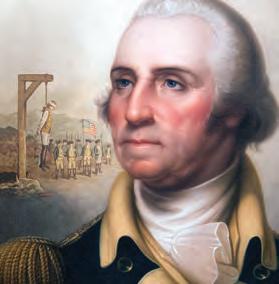

The Day the War Was Lost It might not be the one you think Security Breach Intercepts of U.S. radio chatter threatened lives 50 th ANNIVERSARY LINEBACKER II AMERICA’S LAST SHOT AT THE ENEMY First Woman to Die Tragic Death of CIA’s Barbara Robbins HOMEFRONT the Super Bowl era WINTER 2023 WINTER 2023 Vicksburg Chaos Former teacher tastes combat for the first time Elmer Ellsworth A fresh look at his shocking death Plus! Stalled at the Susquehanna Prelude to Gettysburg Gen. John Brown Gordon’s grand plans go up in flames MAY 2022 In 1775 the Continental Army needed weapons— and fast World War II’s Can-Do City Witness to the White War ARMS RACE THE QUARTERLY JOURNAL OF MILITARY HISTORY WINTER 2022 H H STOR .COM JUDGMENT COMES FOR THE BUTCHER OF BATAAN THE STAR BOXERS WHO FOUGHT A PROXY WAR BETWEEN AMERICA AND GERMANY PATTON’S EDGE THE MEN OF HIS 1ST RANGER BATTALION ENRAGED HIM UNTIL THEY SAVED THE DAY JUNE 2022 JULY 3, 1863: FIRSTHAND ACCOUNT OF CONFEDERATE ASSAULT ON CULP’S HILL H In one week, Robert E. Lee, with James Longstreet and Stonewall Jackson, drove the Army of the Potomac away from Richmond. H THE WAR’S LAST WIDOW TELLS HER STORY H LEE TAKES COMMAND CRUCIAL DECISIONS OF THE 1862 SEVEN DAYS CAMPAIGN 16 April 2021 Ending Slavery for Seafarers Pauli Murray’s Remarkable Life Final Photos of William McKinley An Artist’s Take on Jim Crow “He was more unfortunate than criminal,” George Washington wrote of Benedict Arnold’s co-conspirator. No MercyWashington’s tough call on convicted spy John André HISTORYNET.com February 2022 CHOOSE FROM NINE AWARD WINNING TITLES Your print subscription includes access to 25,000+ stories on historynet.com—and more! Subscribe Now! HOUSE-9-SUBS AD-11.22.indd 1 12/1/22 5:22 PM
Eye of the Beholder
Though often mocked today as Gettysburg’s “ugliest” monument, the 20th Massachusetts’ “Puddingstone” boulder memorial held special significance to the unit’s veterans.


Point of Order
MANY UNION VETERANS HAD TO SWALLOW SOME PRIDE WHEN PLACING THEIR GETTYSBURG MONUMENTS
By D. Scott Hartwig
WHEN I WORKED at Gettysburg National Military Park, I regularly encountered visitors who imagined that some type of grand government master plan had created the park and accounted for the order and symmetry of its hundreds of monuments. Yet there is no master plan. The battlefield we see today with its orderly placement of monuments evolved over many years. The park was officially created by congressional legislation in 1895, but most of the regimental monuments were erected in the 1880s, before the U.S. government assumed responsibility for managing the battlefield.
At the time, the field was managed by the Gettysburg Battlefield Memorial Association, an organization created in 1864, which initially viewed the battlefield as a monument to the Union victory of July 1863. It sought to acquire land where evidence of the conflict still existed, such as Culp’s Hill, East Cemetery Hill, and parts of Little Round Top—with their bullet-riddled trees, artillery lunettes, breastworks, and entrenchments.
In its early years, the GBMA was largely a local organization with a modest budget. Although it supported the idea of marking positions of Union Army units “by tablets, obelisks and other monumental structures,” its efforts centered on lobbying Northern states to pass laws and appropriate funds to make this a reality.

In 1880, the GBMA underwent a transformation, electing a new slate of officers and directors who had a larger vision than the original board. One of their decisions that would have far-reaching consequences for how regimental monuments would be located and what their inscriptions could say was to invite the amateur historian John B. Bachelder to join the board. Although he had not served in the Army during the war, Gettysburg had become Bachelder’s life work, and he was considered the expert on the battle. Former Union Maj. Gen. Henry Slocum wrote that Bachelder “can tell more of what I did there [at Gettysburg] than I can myself.”
In July 1883, the board elected Bachelder as Superin-
18 AMERICA’S CIVIL WAR
COURTESY OF THE ADAMS COUNTY HISTORICAL SOCIETY MAURICE SAVAGE/ALAMY STOCK PHOTO; COURTESY OF THE ADAMS COUNTY HISTORICAL SOCIETY
FROM THE CROSSROADS
ACWP-230400-CROSSROADS.indd 18 12/12/22 12:26 PM
tendent of Tablets and Legends. In this role he approved the proposed location, design, and inscription for regimental monuments.
When monuments went up had much to do with when state legislatures appropriated funding for them. Massachusetts, for example, appropriated $500 in March 1884 for each regiment and battery of the state that had fought at Gettysburg. It would be up to the veterans of each unit to raise any additional funding necessary beyond this total. The result was almost all Massachusetts’ regimental and battery monuments went up in 1885 and 1886.
In October 1885, the 15th, 19th, and 20th Massachusetts placed their monuments—with Bachelder’s and the GBMA’s approval—on the southern edge of the famous Copse of Trees, to which they had advanced during the repulse of Pickett’s Charge on July 3. Bachelder, however, had second thoughts on allowing units to erect their principal monument at the point of their farthest advance. Ten other regiments had crowded into the same space the three Massachusetts regiments had in the counterattack to drive back the Confederate breakthrough near the Copse. If he allowed all these regiments to follow the Massachusetts example, the result would be a jumble of monuments near the trees. This, he believed, would “mislead the public in the future rather than illustrate the battle.”
While it was understandable that veterans wished to place their monument where they had lost the most men or achieved their greatest success, this could lead to clumps of monuments that would baffle future generations not steeped in Gettysburg’s history, not to mention foment interminable arguments between veterans over who was where and when.
of the 15th, 19th, and 20th Massachusetts to move their monuments from their advance positions at the Copse to their July 2-3 lines of battle. The veterans agreed, though for the 19th Massachusetts that meant moving its monument to the second line of battle, where it had served in support. To soften the blow, each regiment was allowed to place an iron tablet at its advance position, where their monuments had originally been placed.
The new policy was generally a success, bringing a sense of order to how the field would be marked. Through the 1880s, the GBMA opened avenues that followed the Army of the Potomac’s general lines while creating access to the monuments being erected. But determining “line of battle” proved to be a gray area. For example, all the monuments to Caldwell’s 1st Division, 2nd Corps, are in the Wheatfield area to which the division advanced on July 2, rather than where the division was in line on the southern end of Cemetery Ridge most of the day. Artillery batteries were tricky because many of them moved numerous times throughout the battle. In these cases, Bachelder and the GBMA compromised and worked with veterans to meet the spirit of the policy but still honor the service of the unit.
Wish We Were Here
Later moved, the 19th Massachusetts’ memorial was first placed at the regiment’s July 3 advance position near the Copse of Trees.
To resolve the issue, Bachelder met with Secretary of War William C. Endicott and Regular Army officers who had been in the volunteer service during the war. They reached a decision “that the desire of the memorial association would be better carried out if the lines of battle were marked, rather than the lines of contact when any regiment left their position to go into action.”
In effect, regiments and batteries would mark the principal position they occupied in the general line of battle rather than to where they eventually advanced. Inscriptions on each monument could explain the regiment’s actions and movements. Once a regiment had erected its principal monument, it could place an advance position marker/monument/tablet if desired. In December 1887, the GBMA formally adopted this “line of battle” policy.

One of Bachelder’s first tasks was convincing veterans

The War Department continued this policy after the creation of Gettysburg National Military Park in 1895, when it assumed responsibility for all the lands of the GBMA. It generally worked well for the Army of the Potomac, but when the Confederate side of the field began to be acquired, Army of Northern Virginia veterans had little interest in erecting monuments on their “line of battle” positions, which were where their attacks originated from, not where they suffered their principal loss. But they also had less incentive than Union veterans to erect monuments, for starting in the 1890s the War Department marked the position of every brigade, battery, division, and corps of both armies with iron tablets. These tablets adhered to the same line of battle policy and typically marked where units were in position immediately before the fighting began.
Monuments are about memory, and numerous battles were fought over the years between veterans, and with the GBMA, over where a particular monument would be placed and what constituted the unit’s position in the line of battle on a particular day of the battle. But overall, the association’s policy was a success and reflected Bachelder’s vision in making the Gettysburg battlefield comprehensive for generations to come.
SPRING 2023 19
THE CROSSROADS COURTESY OF THE ADAMS COUNTY HISTORICAL SOCIETY MAURICE SAVAGE/ALAMY STOCK PHOTO; COURTESY OF THE ADAMS COUNTY HISTORICAL SOCIETY
FROM
Scott Hartwig writes from the crossroads of Gettysburg.
ACWP-230400-CROSSROADS.indd 19 12/12/22 12:26 PM
Separation Clause
South Carolina’s 1832 threat to secede was later realized in 1860, an impetus to the Civil War, as ridiculed by this political cartoon.

‘Have we come to this?’
WITH SECESSION AT STAKE IN 1830, S.C. LEGISLATOR PLEDGES UNION
By Brian C. Neumann
THE UNITED STATES came perilously close to civil war during the 1832 Nullification Crisis. After Congress passed a high protective tariff in May 1828, dramatically increasing taxes on many imported goods, protests erupted across the South—growing particularly violent in South Carolina. Hurt by a decade of economic decline and a series of slave panics, many South Carolinians considered the tariff a plot to impoverish the South and undermine slavery. Many championed nullification, insisting that states had the power to declare federal laws null and void. The most radical Nullifiers went even further, calling for outright disunion and armed resistance.
Nullifiers won control of the General Assembly in 1830, and just two years later held a commanding three-fourths majority. The state’s governor, senators, and most congressmen were also Nullifiers. In November 1832, a state convention issued the Ordinance of Nullification, declaring the tariff unconstitutional and threatening to secede if the fed-
eral government moved to enforce it. Nullifiers mobilized for war, with 25,000 men volunteered to defend their state against federal “tyranny.” As one volunteer proclaimed, “the fact is now probably obvious that we must fight.”
Yet South Carolina was starkly divided, with 40 percent of voters—generally older men, those owning fewer slaves—fiercely opposed to nullification. In their view, the Union was a bold but fragile democratic experiment, the “last hope of liberty” in a world ruled by kings and emperors—that nullification would prove humanity was incapable of self-government.
Southern Accent is produced in partnership with the Nau Civil War Center at the University of Virginia, which promotes scholarship, teaching, and public outreach regarding the United States in the Civil War era. It draws upon UVA’s rich resources, faculty, and students.
Among these “Union” men was William McWillie, a state legislator from Camden. Born in 1795, he had served in the War of 1812 and was admitted to the bar in 1818. A planter who owned nearly 200 enslaved laborers, he reportedly considered “the law more a pastime than a profession.” Elected to the General Assembly in 1829, he would spend several years, however, arguing against nullification. His oratory skills particularly shone

20 AMERICA’S CIVIL WAR SOUTHERN ACCENT
GRANGER, NYC 914 COLLECTION/ALAMY STOCK PHOTO ACWP-230400-SOUTHERN.indd 20 12/12/22 9:25 AM
during a December 1830 debate on whether a state convention should be called to nullify the tariff. The “hopes of mankind,” he argued, rested on survival of the Union.
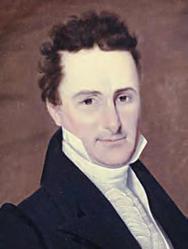

Mr. Chairman—I agree to the fullest extent...as to the importance of the resolutions now submitted to the consideration of the committee; not only to this state, but to the United States; and perhaps to the world. The subject overwhelms me….
When we nullify, I am persuaded, it will be the beginning of violence, and this republic will be no more. Have we come to this? Are we prepared to say we will no longer be called the countrymen of Washington; and that the history of the revolution and [the War of 1812] shall no longer be our history? Are we prepared to say, that the eagle, the emblem of our national glory, shall no longer be our eagle? That our beautiful standard, the standard of stars and stripes, emblematical of the union of these states, shall no longer be our standard? Are we prepared to discard this standard, with which is associated all that we have of national character, and around which our fathers rallied when they drove the proud oppressors from our shores: that standard which has floated broad and high, triumphant and glorious in the rush of many a fight, where the strongest of our countrymen have striven, and the bravest have bled? Can we deface its honors? Will we trample it in the dust? Shall all that has been said of it in rhetoric, in poetry and in song, be heard no more? No. I at least for one, must answer no—of this my conscience will be clear….
bow at the feet of despotic power? Was I a slave? No! I was then as I now am, a freeman; a citizen of this happy, vast and powerful republic; an American citizen….
I would ask this committee, if...our beautiful and happy institutions, on which rest not only our own national character and glory but the hopes of mankind, are to be permitted now to perish? Is man destined ever to be the slave of legal forms? Is liberty but an ignis fatuous gleam...ever to be pursued, but never to be grasped? I trust not—I believe that man is capable of self government—it is for us...to prove the fact—it is for us to assert the dignity of his nature, and shew his capacity for self control. God grant that the predictions of our enemies may not be fulfilled—but that our government, the world’s last hope, may continue forever in her onward course; and that her example may be to the enslaved nations of the earth, like the pillar of cloud by day, and of fire by night; conducting them to happiness and freedom....
If the American people are true to themselves, this will be. Our fields shall ever brighten under their golden harvests; our commerce shall press the bosom of every sea; our armies shall hurl back the invaders strength; and our fleets, whitening the heavens with their canvass, shall sweep the ocean with the thunder of their cannon….
About Face
Unionist William McWillie later pledged to secede as governor of Mississippi over the issue of slavery.
We have been told [by Nullifiers] that the object of the north and west is to emancipate our slaves, to destroy our property. This is an argument I did not expect to hear in this house. It is a subject, although a slaveowner, on which I have no apprehensions…I have no fears in this matter from the general government; but I have sometimes feared the effect of our own madness and temerity. If any thing would be likely to destroy the value of this property, it would be disunion and civil war. We might then hear the shout of liberty, from quarters which would appal [sic] the stoutest hearts. We might realize the horrors of St. Domingo; where the labours of man, the monuments of art, where infancy and age; woman’s feebleness and man’s strength, were swept away in one vast, overwhelming tide of blood…
We have been told that our government is the most positive despotism on earth—and that our people are the most oppressed. Can this be true? Has my life been all one delusion? When in the midst of revelry and of songs, the joyous acclamations of freemen, and the thunder of artillery, I have celebrated her triumphs and her glory—was I deluded? Were manacles then upon my hands, and did I
Oh God! Let my country live to see this... consummation, in which all the fond hopes of the patriot’s heart shall be lost in the fulness of fruition; and that we, as one people, may go forward, gloriously and forever with freedom’s soil beneath our feet, and...the broad and glorious banner of stars and of stripes, the banner of the union, proudly streaming o’er us.
Nevertheless, in 1832, state officials passed an Ordinance of Nullification to bring the nation closer to civil war. In reply, about 9,000 South Carolinians joined paramilitary Union Societies, vowing to fight even their own friends and neighbors. Congress defused the crisis in March 1833, agreeing to lower tariff rates over the next nine years. But even when the ordinance was voided, tensions remained high. “[T]he tariff was only their pretext,” Jackson wrote, “and disunion and a Southern confederacy the real object. The next pretext will be the negro, or slavery, question.”
Having moved to Mississippi, McWillie was elected to Congress in 1849. Amid another sectional crisis in 1850, he pledged enduring devotion to the Union, although he was quick to blame Northern abolitionists rather than Southern radicals for endangering the country. As governor of Mississippi in 1857-59, however, he pledged to dissolve the Union rather than surrender slavery.
Brian Neumann is the author of Bloody Flag of Anarchy
SPRING 2023 21
ACCENT
SOUTHERN
GRANGER, NYC 914 COLLECTION/ALAMY STOCK PHOTO ACWP-230400-SOUTHERN.indd 21 12/12/22 9:25 AM
LoOse lips
Northern newspapers were culpable in aiding Confederate intelligence during Burnside’s North Carolina Expedition of 1862
 By Bruce Allardice
By Bruce Allardice
22 AMERICA’S CIVIL WAR
ACWP-230400-BURNSIDE.indd 22 12/13/22 8:50 AM
In January 1918, as U.S. participation in World War I neared its first anniversary, historian James G. Randall of the University of Illinois wrote perhaps the definitive article on Northern newspapers and military secrecy during the Civil War. Randall’s magisterial account, appearing in The American Historical Review, served a dual purpose. He intended it both as an overview of a dilemma Union armies faced during the Civil War and as a gentle reminder to U.S. newspapers that might feel emboldened to follow suit in similar scenarios in World War I. “The Ameri-
can Civil War presents a significant field for study in this connection,” Randall wrote, “for the double reason that a period of remarkably keen journalistic enterprise coincided with a time of laxity in the matter of press control. Acting under no effective government restraint, the newspapers of the North, though in many ways deserving of admiration, undoubtedly did the national cause serious injury by continually revealing military information.”
As Randall showed, occasions when Northern newspapers were all too ready to publish sensitive military information to an eager public—
Firm Base
Union troops land on Roanoke Island early in Ambrose Burnside’s 1862 North Carolina Expedition. Control of the island, defended by 3,000 Rebel troops, was essential to any hope of the expedition’s success.

SPRING 2023 23
ACWP-230400-BURNSIDE.indd 23 12/13/22 8:50 AM
and to ever-vigilant enemy spies and commanders—were plentiful.
The process of how military intelligence has been gathered and implemented has evolved gradually since the Civil War, and continues to evolve today. Modern U.S. Army doctrine breaks the process down into four general categories: Role; Target; Intent; and Functions. Below, by examining Union Maj. Gen. Ambrose Burnside’s 1862 North Carolina Expedition, we expand on Randall’s 1918 thesis through the lens of this modern Army doctrine.
In the fall of 1861, Maj. Gen. George B. McClellan, the Union Army’s general in chief, endorsed creating a “coastal division” for operations against Confederate coastline targets. “Little Mac” tapped Burnside, an old friend, to organize and lead the expedition.

Burnside formed mostly newly raised regiments, many specially recruited in New England coastal communities where most would have some experience with boats. He organized his force into a three-brigade division of about 15,000 men, concentrated at Annapolis, Md. In early January 1862, this force, transported by a large armada, left Annapolis and attacked the North Carolina sounds. It achieved some success, against badly outnumbered and ill-equipped Southern opposition.
Confederate military leaders were known to regularly scan Northern newspapers for information. In late 1861, the lines along the Potomac River were ill-guarded, and Confederate pickets could be found within 20 miles of Washington, D.C. That, along with an abundant number of Confederate sympathizers in the capital and Maryland, usually allowed nextday access to these newspapers.
General Robert E. Lee, Randall noted, “constantly perused the columns of these journals with the eye of a military expert on the lookout for information.” Lee would then pass the newspapers on to President Jefferson Davis, with comments on items he believed were of special interest.
Randall cited four specific instances when Lee had made moves in response to what he had discovered in these papers.
After the First Battle of Bull Run, acerbic Union Brig. Gen. William T. Sherman, complained that “the press…gave notice of [our] movement on Manassas, and enabled [Joseph] Johnston’s army so to reinforce [P.G.T.] Beauregard that our army was defeated.”
The Official Records of the War provide evidence that Confederate intelligence operatives regularly received information on Burnside from Northern newspapers. For example, on January 4, 1862, Confederate Colonel Thomas Jordan forwarded the following extract from the December 28, 1861, National Intelligencer to the War Department in Richmond.
“General Burnside is awaiting the arrival of gunboats and transports at Annapolis. Sixteen transports, four schooners, and five floating batteries are already there. The naval rendezvous will be at Old Point Comfort [Fort Monroe], and it is said that Captain Goldsborough is assigned to the command.”
From an intelligence standpoint, it is in the categories of capabilities and order of battle that Northern newspapers did the most damage. On September 28, 1861, with the expedition still in the planning stages, the national magazine Harper’s Weekly proclaimed that Burnside would lead “at least 10,000 men” in a move to flank the rebel armies in northern Virginia, and “to take Norfolk in the rear.” That was a remarkably accurate estimate of the force eventually used, that it would be commanded by Burnside, and that Norfolk was the likely target, as the Confederate port stronghold could be taken only from North Carolina’s Pamlico and Albemarle sounds, via canals connecting those sounds to Norfolk.
Such disclosure of Burnside’s numbers was critical. As has been well-documented, McClellan tended to let his operational choices in 1862 be influenced by a gross overestimate of Confederate army numbers. The flip side is that an accurate knowledge of Burnside’s numbers and capabilities better enabled the Confederates to conjecture on Burnside’s destination.
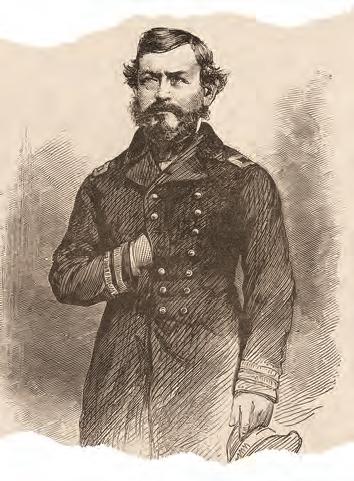
Boatloads of Expertise
L.-R.: Flag Officer Louis M. Goldsborough and Ambrose Burnside. Goldsborough led the North Atlantic Blockading Squadron, providing the mission’s naval thrust. Made a midshipman when he was only 7, he spent an incredible 61 years in the U.S. Navy.
Worse would come soon. On October 7, The Providence Evening Press reported that Burnside “expects to have ten regiments [about 10,000 men] under his command,” and named several of the regiments. This information made
24 AMERICA’S CIVIL WAR
HARPER’S WEEKLY PREVIOUS PAGE: CLASSIC IMAGE/ALAMY STOCK PHOTO; THIS PAGE: HARPER’S WEEKLY (2) ACWP-230400-BURNSIDE.indd 24 12/14/22 10:28 AM
For Your Information
In late 1861, his expedition still in the planning stages, Burnside held a grand review in Annapolis. For eager readers on either side, Harper’s Weekly left no secret that the army pictured here was indeed “Burnside’s Expiditionary [sic] Force.”
it south, as The Savannah Morning News soon echoed that report of Burnside’s numbers and projected he was aiming for the Chesapeake Bay. (That isn’t to say the information provided in those early days couldn’t be sketchy. There were inaccurate newspaper reports that Brig. Gens. Isaac Stevens and Thomas W. Sherman would have commands in the expedition.)
On October 23, Burnside was ordered to concentrate his division at Annapolis. It took less than a week for this rendezvous location to leak out, with The New York Herald of October 30 conveniently informing the world that the 51st New York Infantry was not only part of the expedition but also had been ordered to Annapolis. Newspapers kept up a steady stream of reports detailing the exact regiments, and their commanders, ordered to join Burnside.

The actual destination of the expedition, however, had not been settled yet. Newspaper accounts speculated on three likely targets, the same three targets that any competent Confederate officer would have assumed: the Chesapeake Bay area, in conjunction with a move by McClellan’s main army; the North Carolina sounds; or the Charleston–Savannah region, reinforcing Union troops already at Port Royal, S.C. Here Burnside committed an error. On November 7, while in New York City securing vessels, he addressed a gathering of exiled North Carolina Unionists. It was unnecessary for a
serving general to address a civilian gathering, and Burnside’s interest in North Carolina was widely reported. Fortunately perhaps, other early November newspapers speculated his target would be Port Royal.
Early Confederate intelligence was divided on the potential point of attack. As early as October 1861, spies connected to Rose Greenhow’s Washington-based ring reported the target to be North Carolina, but as late as January 4, 1862, Jefferson Davis had received information that the Potomac River was Burnside’s target, in connection with an advance by McClellan’s army.
In a true gift to the Confederacy, The New York Herald (which seems to have been the worst of the Northern newspapers when it came to leaking secrets) ran a lengthy article in early November giving the names of all the regiments and their commanders then at Annapolis, plus their strengths, their armament (mostly Enfield rifles), and even details of the baggage train that had been gathered. From this information on numbers and capabilities, the Confederates could easily discern that the expedition was not equipped for large-scale operations outside coastal areas.
On November 19, one Washington newspaper listed the 15 regiments and their commanders that made up Burnside’s division. On the 28th, the Herald printed a complete breakdown of Burnside’s troops, with biographies of the officers, the names of the transport vessels, even details of their pontoon train. The next day The Philadelphia Press also listed the regiments, the names of the generals and colonels, and the names of the staff officers and vessels. We know from The Official Records that these lists of units and vessels were remarkably precise. Every newspaper report of the expedition gave fairly accurate information about its strength and
SPRING 2023 25
HARPER’S WEEKLY PREVIOUS PAGE: CLASSIC IMAGE/ALAMY STOCK PHOTO; HARPER’S WEEKLY (2) ACWP-230400-BURNSIDE.indd 25 12/13/22 8:52 AM
Burnside was ordered to concentrate his Division at Annapolis. It took less than a week for that to leak out.
order of battle, although at this time reports varied on the destination and timing of the expedition. Frank Leslie’s Illustrated Newspaper admitted the expedition’s destination to be unknown, but “it may be Mobile, New Orleans or Galveston”—all in the Gulf of Mexico. Both The New York Tribune and The Chicago Tribune considered the York River (Chesapeake Bay) the likely target, working in conjunction with McClellan’s main army.
Perhaps the worst leak—certainly the most visual—came from Harper’s Weekly. Its January 4, 1862, issue featured a full page of illustrations of “Genl. Burnside’s Expedition,” depicting the fleet, with the names of the vessels given.
Harper’s admitted that the destination “is, of course, secret” but surmised that it would operate from a base not far from Fort Monroe (i.e., either the Chesapeake Bay or North Carolina).
Just from the list of vessels, and their known
The Usual Suspect
Harper’s Weekly was a leading source of the critical information typically shared by many Northern publications. The size of Burnside’s force is evident in this Harper’s illustration from its January 4, 1862, edition. It was quite clear this wouldn’t be a minor operation.
tonnage, the Confederates could estimate both the numbers of troops the ships could transport and the amount of supplies carried, which would serve to narrow the list of possible targets.
In case the Confederates did not have Harper’s handy, on the same day The Washington Evening Star provided similar information, adding that the vessels were almost fully loaded and ready to depart. This newspaper identified the caliber of the cannon on each ship, the ship’s draught and size, and told the world that the Annapolis boats would meet up with other naval warships already at Fort Monroe. Confirming the Fort Monroe speculation, The Lowell (Mass.) Daily Citizen of January 9 printed a letter from a captain of the 25th Massachusetts Infantry saying he had been ordered to prepare only three days’ rations, indicating a long cruise (i.e., to Port Royal or the Gulf) was not contemplated.
In fact, on January 2, 1862, Burnside had met with McClellan and final orders were issued for the expedition to depart as soon as possible, for the North Carolina sounds. The transports left Annapolis on January 9-10, rendezvoused with other vessels at Fort Monroe on the night of the 10th, and finally departed for Hatteras Inlet (the entrance to the North Carolina sounds) on January 11. Northern newspapers promptly reported all these moves. The Port Tobacco (Md.) Times of January 9, followed by The Philadelphia Press and The Baltimore American, announced Burnside’s departure. On January 11, The Washington Evening Star noted that while the troop vessels had sailed by the 10th, vessels loaded with “stores, etc.” would not depart for two or three more days.
The fleet’s arrival at Fort Monroe could be seen from nearby Confederate-held Norfolk. As early as January 9, newspaper reports circulated that Burnside’s advance vessels had reached that bastion. The Newark (N.J.) Journal reported on January 13 that Burnside and his staff arrived at the

26 AMERICA’S CIVIL WAR WETDRYVAC/ALAMY STOCK PHOTO; HARPER’S WEEKLY HARPER’S WEEKLY
ACWP-230400-BURNSIDE.indd 26 12/13/22 8:52 AM
The route that Goldsborough’s naval vessels followed to reach Roanoke Island had them proceed down the Atlantic Coast from Fort Monroe, Va., and cross into Pamlico Sound just past Cape Hatteras. Considering the time of year, those vessels inevitably battled dire weather and rough seas throughout. The hazardous nature of the voyage appeared in this illustration published in The London Illustrated News on February 22, 1862.

fort on the 11th, while The Providence Journal and Washington Evening Star assured readers that Burnside was heading toward Pamlico Sound.

Burnside seems to have been aware of these newspaper leaks, although (as can be seen) his efforts to stop them failed. On January 10, The New York Tribune blandly and incorrectly asserted that “the secret of [Burnside’s] destination and field of operation has been well kept.” The Boston Morning Journal of the 13th even claimed that “General Burnside is determined that no indiscreet correspondent shall make public any details concerning his expedition, or its destination, until it is safe to do so” and claimed that Burnside had quarantined reporters on one of his ships to prevent word leaking out. Given the tsunami of leaks to the press, one wonders if these newspapers took what they wrote seriously, or whether they were trying to “butter up” the general in order to get more “scoops.”
Burnside himself became a chief offender. On January 14, The Cincinnati Daily Commercial gave out all the details of the expedition. The report was datelined the 5th, but not released until nine days later, as Burnside had asked the reporters not to release it until he deemed it “safe” to do so. This report (accurately) named the North Carolina coast, and Roanoke Island, as the first targets. It cited a force of 16,000 men and 53 cannons, astonishing (and accurate) detail that a Mata Hari would have been proud to have discovered.
The vessels were said to contain only eight days’ worth of coal and 10 days of food, confirming a short voyage (i.e., North Carolina). And with the troop-laden vessels still at sea, several Northern newspapers (from The Washington Evening Star to The Cleveland Daily Dispatch) printed these facts, and specified the Tar Heel State as the target. As the voyage
to North Carolina, which normally was a matter of a few days, could take—and, in fact, did take—weeks to complete due to gale-force winds, Burnside’s notion of when it was “safe” to unleash the newspapers seems wildly optimistic, almost criminal—certainly a violation of any notion of secrecy.
The Philadelphia Inquirer of January 18 published a report in such detail that it could have come only from a member of Burnside’s staff. After listing the brigades and regiments in each brigade, with their commanders (accurately in each case), it furnished a list of all the company officers of every regiment, down to the 2nd lieutenants, and on which vessels each regiment had embarked. Details of the pontoon train, the cost and composition of the artillery ammunition, names of even the junior signal officers, and more, were disclosed. The article claimed that “Gen. Burnside has afforded the press every facility for obtaining” these priceless details, which casts serious doubts on Burnside’s later claims that he clamped down on security.
Lest anyone on either side was still in doubt as to Burnside’s target, The New York Sun of January 24 printed a long article on the expedi-
SPRING 2023 27 WETDRYVAC/ALAMY STOCK PHOTO; HARPER’S WEEKLY HARPER’S WEEKLY
That’s One Treacherous U-Turn
ACWP-230400-BURNSIDE.indd 27 12/13/22 8:52 AM
Making Themselves at Home
Federal troops disembark at Roanoke Island on February 7, 1862. The island soon became the site of a prosperous, though shortlived, Freedman’s Colony.

Left:
tion complete with a map of the North Carolina sounds. The New York Herald on the 28th printed another map of the region and filed a long report on ships that Burnside had lost in the storms, together with the names of the units on board the lost ships. The names of the five ships lost, with their cargoes, match up with the actual losses. In addition, the reports on the storm and the difficulties the ships had in getting over the shallow inlet waters, explained to the world the reasons for the delay in the attack. This almost-real-time update would be the last actionable newspaper leak prior to the attack.
It took until February 5 for the entire fleet, buffeted by gales that almost sank Burnside’s headquarters vessel, to anchor off Roanoke Island and transfer to shallower draft vessels that could enter the sounds. The troops commenced their attack two days later. The newspaper reports thus gave the Confederate authorities nearly three full weeks’ notice of the intended site of attack. Southern newspapers even reported the impending attack, and urged the government to react, though there was still some doubt as to where in the sounds the first attack would be made.

Fortunately for Burnside, the Confederacy had few resources available to move to the threatened area. The Confederate high command denied requests by the local commanders
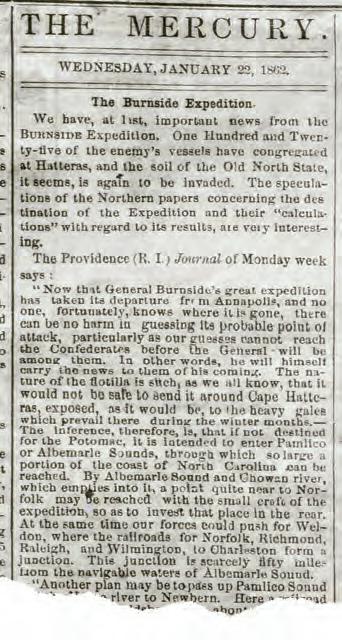
28 AMERICA’S CIVIL WAR LIBRARY OF CONGRESS LIBRARY OF CONGRESS; THE MERCURY (2)
All the News That’s, Umm, Fit to Print
ACWP-230400-BURNSIDE.indd 28 12/13/22 8:52 AM
This detailed listing of U.S. naval strength for the expedition, from armed troop ships and gunboats to pontoon bridge schooners, appeared in the January 15, 1862, edition of The Chicago Tribune. Right: The Charleston Mercury took advantage of information provided by Northern competitors for this report published on January 22, 1862.
to reinforce the area. Thus, despite knowing in advance this priceless information (all the information any army could reasonably ask for), the outnumbered and outgunned Confederate defenses in the area collapsed.
Why were army officers and reporters so cavalier about military security early in the war? For reporters, the answer seems obvious: the leaks were “news” and sold newspapers. After all, the information was from army sources, and why would reporters hold themselves to a higher standard of security than the army itself? There was neither an American newspaper tradition of keeping secrets, nor a law that made it illegal to report those secrets. Army officers such as General Burnside had less excuse for the lax security. It must be remembered that most army officers had been, six months before, civilians, who at a minimum had no background regarding military security. Many officers were prewar politicians who had spent their lives seeking newspaper publicity. Regular Army officers like Burnside, however, should have known better.

A look at the Mexican War, in which the U.S. Army paid little attention to newspaper security, is instructive. As that war was fought in Mexico, the Army had much greater control over such reporting. But by 1861, the information infrastructure of telegraphs and railroads had developed to the point where news could be transmitted in mere days, if not hours. Civil War army officers’ Mexican War experience little prepared them for dealing with that sea change.
For at least the first year of the Civil War, the Confederacy didn’t need an organized intelligence-gathering service in the North—at least, one along the lines of modern military intelligence. Northern newspapers did that job for free. Burnside shared a lot of the blame for openly cooperating with the newspapers.

Modern military intelligence services would gladly pay tens of millions of dollars to obtain the kind of information on numbers and intentions that Northern newspapers provided the Confederacy. The newspaper information on Union numbers, order of battle, and capability was nearly always accurate, and eventually even Union intentions were disclosed. The famous spies of history, from Mata Hari to the Rosenbergs, lost their lives to obtain a mere fraction of the militar y intelligence that the South received virtually risk-free.
Fortunately for the Union, security tightened
Below the Fold
When Maj. Gen. Ambrose Burnside wasn’t making news, he enjoyed reading it, as he is in this Mathew Brady photograph, taken at the Army of the Potomac headquarters during the May 31–June 12, 1864, Battle of Cold Harbor. The photo, Burnside later wrote, was “taken without my knowledge. Mr. Brady had finished with us and I sat down on a sack of oats to read a paper someone had handed me. When he [Brady] told the operator to take us. He came in and sat down in the group.” Brady is pictured in the forefront in the chair facing Burnside.

The newspaper is folded in half, with Burnside apparently reading part of the bottom half of the first page. Some recent digital detective work by Jim Studnicki, founder of Creekside Digital, and the Center for Civil War Photography has determined that in the photo Burnside is reading the Saturday, June 11, 1864, Daily Morning Chronicle and the photo was taken on June 12, 1864.
What is Burnside reading? On this page of the paper, Burnside and the Army of the Potomac are mentioned several times in an article titled, “Rebel News by way of London,” but Burnside appears to be reading another section titled “LATEST NEWS. OFFICIAL WAR BULLETIN,” which begins at the top of the fourth column.
up as the war progressed. An analysis of newspaper reporting of a similar troop movement in 1863—the transfer of the 11th and 12th Corps from Virginia to Chattanooga—proves that newspaper mentions were few and scattered, with none giving the kind of troop-strength details seen in late 1861–early 1862. By no coincidence, the more the Union Army kept its secrets out of the newspapers, the better it performed.
Bruce Allardice, who teaches history at Illinois’ South Suburban College, is past president of the Chicago Civil War Round Table and has authored or co-authored seven books and numerous articles, on the Civil War and on the history of baseball.
SPRING 2023 29 LIBRARY OF CONGRESS LIBRARY OF CONGRESS; THE MERCURY (2)
ACWP-230400-BURNSIDE.indd 29 12/13/22 11:15 AM
SunshiNE staTe SHowdOWn
Though too late to change the war, a Rebel victory at Natural Bridge gave Florida a slice of history
 By Sheritta Bitikofer
By Sheritta Bitikofer
30 AMERICA’S CIVIL WAR
ACWP-230400-NATURALBRIDGE.indd 30 12/13/22 8:59 AM
It probably seems easy to downplay Florida’s contributions to the Civil War. After all, the state fielded only about 15,000 soldiers to the Confederate cause—a pale number when compared, for instance, with Virginia’s 155,000 or Tennessee’s 120,000—and no major battles tore apart its fertile soil. Also, because many of its major cities and ports fell to Union occupation early in the war, the extent of Florida’s Rebel activity was limited thereafter essentially to raids and minor skirmishes.
Florida, however, has a significant Civil War bragging right to its name: It was the only state east of the Mississippi River whose capital, Tallahassee, never fell to Union occupation—not until the state was handed over in General Joseph E. Johnston’s surrender in April 1865. That achievement would be sealed thanks to a gutty effort by an amalgamation of cavalry, militia, and military school cadets coming together in the Confederacy’s waning days to defeat a larger, more seasoned Union force. Whether Florida would join the Confederate States of America in the winter of 1860-61 wasn’t always a certainty. On January 3, 1861, state delegates convened to consider following South Carolina in secession from the Union. Those in opposition, known as “Cooperatists,” made up 36-46 percent of the votes cast on January 3—primarily representatives from the state’s Whig/Republican northwestern panhandle and northeastern coast,
areas that had developed differently on a social and economic level from central Florida. Their dissension, though, wasn’t enough to combat the Fire-Eaters. Florida’s declaration of secession came a week later, on January 10, 1861.
Across Florida, from Pensacola to St. Augustine, militia and home-guard units began to recruit citizen-soldiers to defend the state, months before the war’s first shots were fired at Fort Sumter. Although several regiments would be shipped off to fight in Virginia, Tennessee, and Mississippi, plenty remained on the home front. The fortifications at Fernandina, St. Augustine, and Pensacola fell into Union hands in the spring of 1862, leaving only central Florida between the Suwannee and Choctawhatchee rivers in Confederate control. This Middle District saw comparatively little action in the first few years of the war, and even less was demanded of it despite its rich cattle and salt resources.
Valiant in Defeat
The 2nd USCT, shown here in 1863 at their first camp in Arlington, Va., arrived in Florida in 1864 after serving in Louisiana. Despite the setback at Natural Bridge, they earned praise from some of their Confederate opponents.

SPRING 2023 31
ACWP-230400-NATURALBRIDGE.indd 31 12/13/22 8:59 AM
That all changed after Vicksburg and Port Hudson fell in the summer of 1863 and Confederate states east of the Mississippi River were severed from Texas’ and Louisiana’s vital beef and salt trade, leaving Florida and Georgia to fill the void. A November 2, 1863, circular issued by Major P.W. White, Florida’s chief commissary officer, implored that all surplus beef supplies in the state be contributed to the Confederate Army. “Our honor as a people demands that we do our duty to [the soldiers],” he wrote. “They must be fed.”
By this time, U.S. officials in Washington, D.C., had escalated efforts to bring Florida back into the fold. That, in particular, stood to benefit Abraham Lincoln’s 1864 presidential campaign, as a large number of Unionists lived there and would certainly provide Lincoln key votes if the state were allowed to rejoin the Union. Clearly, that was part of the motivation for the Union expedition into northeastern Florida in February 1864 that ended in defeat at the Battle of Olustee—a clash that featured two African American regiments: the 35th USCT and the famed 54th Massachusetts.
In early 1865, troops from Cedar Keys, led by Major Edmund S. Weeks of the 2nd Florida Cavalry (U.S.), conducted a raid toward Newnansville with 250 men, including Union sympathizers from Taylor County. To confront the Federal forces, Confederate raiders were sent in by Maj. Gen.
New Horizons
Left: Maj. Gen. Samuel Jones assumed command of the Department of Florida and South Georgia in February 1865 and led the Confederate defense culminating at Natural Bridge. Right: Major Edmund C. Weeks had spent most of the war in the U.S. Navy but resigned to command the 2nd Florida Cavalry (U.S.). He made Florida his home after the war and would even end up serving as the state’s lieutenant governor.
Samuel Jones, newly in command of the Department of Florida and South Georgia. On February 13, the raiders clashed at Station 4 along the railroad near Cedar Keys. The conflict lasted several hours, ending in a Union retreat. Confederate Captain John Dickison, known as the “Swamp Fox,” inflicted more than 70 Union casualties and seized a substantial haul of supplies.

A separate attack by Confederates took place at Fort Myers on February 20, led by Major William Footman’s 275-man “Cow Cavalry” and a 12-pounder artillery piece. That Union stronghold on Florida’s peninsula, known to harbor Confederate deserters, was commanded by Captain James Doyle of the 110th New York and garrisoned by 250 soldiers of both the 2nd USCT and 2nd Florida Cavalry (U.S.).
Although the attack on Fort Myers produced no serious casualties or a loss of resources, it was enough—along with the Cedar Keys news— to grab the attention of U.S. authorities.
Union Brig. Gen. John Newton, named commander of the District of Key West and the Tortugas after the September 1864 fall of Atlanta, felt the Confederate threats needed an immediate response and ordered an expeditionary mission, to be con -

32 AMERICA’S CIVIL WAR PREVIOUS SPREAD: LIBRARY OF CONGRESS; THIS PAGE: COOK COLLECTION, VALENTINE MUSEUM, RICHMOND, VA.; STATE LIBRARY AND ARCHIVES OF FLORIDA LIBRARY OF CONGRESS; NEW YORK PUBLIC LIBRARY
ACWP-230400-NATURALBRIDGE.indd 32 12/13/22 9:00 AM
Highs and Lows
A Virginia-born West Pointer who decided to fight for the Union, Brig. Gen. John Newton commanded the District of Key West and the Tortugas at Natural Bridge. Newton was respected for his dependability. At Gettysburg on July 2, 1863, Maj. Gen. George Meade handed him the 1st Division reins in place of John Reynolds, who had been killed the previous day. In 1864, Newton went west with Maj. Gen. William Sherman—a capable subordinate during the Atlanta Campaign.

ducted in tandem with vessels from the East Gulf Blockading Squadron.
Confident that neither Fort Myers nor Cedar Keys faced imminent danger of further attacks, Newton set out for St. Marks. His principal goal was to harass the area’s Confederates, destroy necessary war assets, and use Port Leon at the mouth of the St. Marks River to defend against blockade-runners. Depending on how that went, Newton wasn’t ruling out an advance on Tallahassee, 20 or so miles north of St. Marks.
Lieutenant Commander William Gibson led the Union fleet accompanying Newton’s effort, which contained 16 vessels—13 of them steam— and carried a landing force of 900–1,000 troops. Among that force were the 99th USCT, 2nd USCT, and 2nd Florida Cavalry (U.S.).
Formed in Arlington, Va., in 1863, the 2nd USCT joined the Department of the Gulf in early 1864, first seeing duty at Ship Island off the coast of Mississippi. Later transferred to Florida, it participated in several engagements contested between Cedar Keys and Key West, and had helped turn back the recent Confederate attack on Fort Myers.
The 99th USCT, meanwhile, began its Union service as the 5th Corps d’Afrique, an engineering unit formed in New Orleans in the spring of 1864. The regiment found itself relegated mostly to fatigue duty and general labor in Louisiana until it too was sent to Florida. During Maj. Gen. Nathaniel Banks’ Red River Campaign retreat in April 1864, the 99th had experienced heavy Confederate fire while in a non-combat role.
Newton’s plan called for troops to make a night landing on Lighthouse Island on March 3, and to take possession of the nearby bridge spanning the East River, just southeast of St. Marks. Other elements of the landing party were to disembark the following morning and advance on Newport, to the northeast (see map, P. 35). After securing Newport—destroying in the process any public establishments that could be used to aid the Confederates—those troops were to advance on St. Marks.
Destruction of railroads connecting St. Marks and Tallahassee, as well as any bridges that could facilitate enemy troop movement to and from the capital, was critical to Union success. Gibson’s fleet was to do its part by silencing any coastal artillery, and a trio of vessels was to be sent upriver to threaten Port Leon directly and land a large support force to prevent enemy interference on the road linking St. Marks and Newport.
The Federal fleet arrived late on the 3rd. Because of strong gales and an impassable bar, a party of only 30 seamen of the schooner USS O.H. Lee could deploy to meet a larger party—90 men—under Major Weeks on the East River. At the East River Bridge, the Federal force scared off a small band of pickets, but soon encountered roughly 45 Confederate cavalrymen, who chased Weeks back to the lighthouse.
While attempting to land troops, the Union vessels Honduras and Spirea ran aground on the hidden bars around Lighthouse Island. Three more ships anchored and deployed troops, who on March 4 advanced a couple of miles inland to await for their artillery and supplies to land. Newton and his men waited until the following morning before setting off in the direction of the East River Bridge. They found it partly dismantled, the planks pulled up by the Confederates, who were now well aware of the
Federal presence in the area. They would also encounter elements of the 5th Florida Cavalry, commanded by Lt. Col. George Washington Scott, defending the bridge from across the river.
The dismounted Confederate cavalry, however, were surprised by the 2nd USCT, forcing an outnumbered Scott to fall back and allowing the Federals to repair the bridge and also capture an abandoned artillery piece and several horses before moving north toward Newport with a force of about 900 men.
Weeks’ March 3 assault on the East River Bridge had greatly alarmed authorities in Tallahassee, who began preparing for a Union onslaught. Should St. Marks fall, they knew, the Confederate capital was in immediate danger.
A factor in the Confederate panic was an inflated estimate of the Union force bearing down on Newport—believed to be 1,500–2,000 troops, although only about half that number were actually present. To deter the Federal advance, the bridge at Newport was burned, and detachments of guards were set up at defensible points between St. Marks and Tallahassee.
A call for more troops was sent out. The batch scrounged together, however, would not bolster
SPRING 2023 33 PREVIOUS SPREAD: LIBRARY OF CONGRESS; THIS PAGE: COOK COLLECTION, VALENTINE MUSEUM, RICHMOND, VA.; STATE LIBRARY AND ARCHIVES OF FLORIDA LIBRARY OF CONGRESS; NEW YORK PUBLIC LIBRARY
ACWP-230400-NATURALBRIDGE.indd 33 12/13/22 9:00 AM
confidence in Confederate success. As The Tallahassee Floridian Journal reported: “The Militia were ordered out and a unanimous and invincible response was made to the call. Every man and boy capable of bearing arms was at his post. Never, since the first commencement of the war, have the people exhibited a greater spirit.”
Florida Governor John Milton determined that the threat also called for the young cadets at Tallahassee’s West Florida Seminary College to join the fray—all boys under the age of 17 who had been training for future military service. The seminary was founded in the mid-1850s as a place of higher learning for young men west of the Suwannee River, but as the sectional crisis escalated, the institute began incorporating military courses into its curriculum. Alumni of the Virginia Military Institute were brought in to manage this new aspect of learning, and after war broke out, the seminary made the military program its primary focus.

Enrollment spiked just before the war before tapering off as boys left to fight in various theaters. Captain Valentine Mason Johnson, a VMI alumnus and Confederate Army veteran, was appointed principal in 1864. Behind Johnson’s lead, the seminary’s revised curriculum intensified.
Blockader
USS Honduras, primarily a supply ship, played a key role in the Union’s Gulf of Mexico blockade and was part of the naval presence assembled at the mouth of the St. Marks River as Newton’s Federals moved toward Florida’s capital.
Experienced Hand
A teacher at Tallahassee’s West Florida Seminary College (left) at the war’s outset, Captain V.M. Johnson (right) left to join the Confederate Army, but returned to the school late in the war to serve as principal. His cadets were part of the victorious Confederate force at Natural Bridge.
Informally, it came to be called the Florida Military Institute.
Many cadets had seen action the previous year when Federal forces advanced toward Olustee and nearby Lake City, Fla. Recalled Cadet William A. Rawls: “All troops, including Home Guards, had been sent to Olustee…all boys big enough to be allowed to go joined them, and went as part of their organization. Many of the Cadets went with them.”
The cadets, Rawls noted, “were [to be] called upon at any time they were needed to perform military duty.” That would be the case in March 1865. Now under Captain Johnson’s command, the youngsters “shouldered their muskets like veterans, and followed with a confidence of inexperience.”

Although the information available to us today varies, it is generally accepted that 34 cadets were enrolled at the school in February 1865. Fewer were involved in defending Tallahassee, however, as many cadets purportedly had to stay behind, not allowed “to go without a written permit from their parents.” Roughly 25 cadets, ages 11–17, would join Lt. Col. Scott’s 5th Florida Cavalry Battalion in the coming engagement.
As they approached Newport, the Federals noticed curling smoke in the distance. Newton sent Weeks and the 2nd Florida Cavalry (U.S.) ahead to investigate, confirming that the city’s bridge over the St. Marks River had been set ablaze by the Confederates. The force under Scott, which included Captain H.A. Gray and the Florida Seminary cadets, had dug rifle pits on the western side of the river, allowing them to enfilade both the river and what remained of the bridge.

34 AMERICA’S CIVIL WAR NAVAL HISTORY AND HERITAGE COMMAND; STATE LIBRARY AND ARCHIVES OF FLORIDA (2)
ACWP-230400-NATURALBRIDGE.indd 34 12/13/22 9:01 AM
In the ensuing three-hour skirmish, the cadets finally received their baptism of fire. Scott’s motley crew stood tall, not budging even in the face of intense artillery fire from two Federal howitzers.
Accountability for several burning buildings in Newport varied depending on the source. The structures, including an iron foundry and a grist mill, had been set aflame either by the Federal aggressors, as a defensive measure by the Confederates, or by embers swept ahead by strong seasonal winds. Nevertheless, Newton determined that crossing the river at Newport was now impractical and decided to divert his army to the north, following an old and unfrequented road about eight miles to a site known as Natural Bridge.
The Confederates would be unable to burn this bridge because, as the name signified, it was a naturally formed strip of land spanning a marshy portion of the St. Marks River. Leaving Weeks and the 2nd Florida Cavalry opposite Newport, Newton redeployed toward Natural Bridge with the rest of his force the night of March 5.
Confederate Brig. Gen. William Miller astutely anticipated Newton’s move, though, and instructed Scott to redeploy a force to the west side of Natural Bridge to prevent a Federal crossing. As more militia and artillery units from Tallahassee became available, Confederate commander Sam Jones rushed them along the Old Plank Road to Scott’s assistance.

Reaching Natural Bridge ahead of the Federal forces, Scott and militia
under Colonel J.J. Daniels began to form light breastworks in a semi-circle around the bridgehead, with their flanks anchored on the swampy ground to provide a solid defense.
A total of six artillery pieces, operated by a hodgepodge of units that had responded to the call for troops, were positioned along the line to direct converging fire on any Federal force that attempted to cross. Scott’s cavalrymen dismounted and extended to the right, while reser ves and militia bridged the gaps between artillery posts with a line of skirmishers on the east side of the bridge. By the height of the battle, a Confederate force numbering anywhere from 600–700 was engaged with Newton’s force of roughly 900.
At 4 a.m. March 6, Major Benjamin C. Lincoln clashed with Confederate pickets while attempting to cross Natural Bridge with Companies B and G of the 2nd USCT. The “sloughs, ponds, marshes, and thickets” proved a major hindrance to the USCT advance, and though the pickets were driven across the bridge, Confederates on the other side checked the Federal push. An intense firefight ensued as artillery
SPRING 2023 35 NAVAL HISTORY AND HERITAGE COMMAND; STATE LIBRARY AND ARCHIVES OF FLORIDA (2)
ACWP-230400-NATURALBRIDGE.indd 35 12/13/22 9:01 AM
“Every man and boy capable of bearing arms was at his post”
Left: “In Loving Memory—Defenders of Natural Bridge” is inscribed on the front of the battlefield park’s monument, erected in 1957. In March 2000, a stone was added along the base to honor all troops who had fought there. Right: This memorial to the USCT soldiers who stopped a Confederate attack on Fort Myers in February 1865 stands in the city’s Centennial Park. Moved at one point, it was repositioned as originally designed on July 29, 2022. Despite the devastation Fort Myers incurred during Hurricane Ian in September 2022, the memorial remained intact.


and musket fire from both sides thundered through the backwoods of Leon County.
The cadets, still at Newport, had been ordered to reinforce the new Confederate position earlier that morning and could hear the battle in the distance. As they drew closer to Natural Bridge, they could see the tops of pine trees severed by Federal artillery fire as well as the body of a killed Confederate. After arriving, they were positioned near the center of the line, just left of Captain Patrick Houstoun’s artillery pieces—told “not to fire a gun unless there was a charge made on the battery.”
As cadet Charles Beard recalled, he and his comrades “were lined up with the troops already there, & at once went to work throwing up some kind of breastwork. We polished our bayonets beautifully in the soft sand, and soon had each man a hole and a small pile of dirt in front of it.”
Once entrenched, they had “nothing to do but sit there and wait,” Beard wrote, adding that they “amused ourselves watching the bark fly from the pine trees and twigs fall from bushes around us, and shake the sand that rifle balls would knock on us, from our breastworks.”
Newton ordered his USCT units to charge, though they were repeatedly foiled by Con-
federate artillery fire. It became clear that although the Federals were not outmanned, they were outgunned. Regardless, the African American soldiers’ tireless determination to carry the enemy position was impressive.
James Dancy, a young artillerist near the center of the line, later described just how hot the fight had been, writing, “If I had put my hat out (but I did not wear one) I could have caught a hatful of bullets.” Cadet Byrd Coles admitted that “no doubt many of the cadets would have been struck if our teachers had not watched us constantly and made us keep behind cover.”
Other attack options were considered, among them a spot for a possible flanking maneuver 1 mile north That was deemed impractical, however, likely because of the difficult terrain.
Advised that a flanking maneuver on the enemy’s right was viable, Newton was unaware that Colonel Caraway Smith’s 2nd Florida Cavalry (C.S.) had arrived that afternoon from Newport to reinforce the Confederate position. Newton ordered Colonel B.R. Townsend and Companies A, B, and H of the 2nd USCT to make another attempt at turning the Rebel flank across the bridge. Meanwhile, Major Lincoln and 2nd USCT Companies E, G, and K would team with Lt. Col. Uri B. Pearsall’s unit from the 99th USCT to provide support.

Despite another valiant effort, the artillery fire was too heavy; Townsend’s men were unable to establish a solid formation on the other side of the bridge. They finally withdrew about 300 yards to regroup, but the 2nd Florida Cavalry (C.S.) misinterpreted the withdraw as a full retreat. Captain H.K. Simmons ordered a charge that was repulsed. Simmons, in fact, was killed in the process, with rumors circulating long afterward it had been friendly fire—that he had been shot in the back by his own men.
Now, Newton had no doubt Natural Bridge was too strongly defended and ordered a retreat to Lighthouse Island and the security provided by the Union fleet. The retreat began about sunset, and the Federal dead and wounded pitifully were left where they lay on the battlefield. Although they would be hampered by felled trees, Scott’s cavalry eagerly pursued the fleeing Federals for a while.
At 4 a.m. the next day, Newton’s Federals arrived back to relative safety at Apalachee Bay. The Union general was quick to blame the setback on a lack of cooperation from the Navy, complaining especially about Gibson’s failure to land a force of seamen at Port Leon and block the road to Newport, as originally planned.
He offered some praise to his officers and
36 AMERICA’S CIVIL WAR
STATE LIBRARY AND ARCHIVES OF FLORIDA; FORT MYERS PARKS AND RECREATION; STATE LIBRARY AND ARCHIVES OF FLORIDA STATE LIBRARY AND ARCHIVES OF FLORIDA
Tributes Both North and South
ACWP-230400-NATURALBRIDGE.indd 36 12/13/22 9:02 AM
Florida Transplant Pennsylvania native George Washington Scott, a Tallahassee-area businessman, became a familiar Federal foe.
men, however, saying “[they] behaved nobly under the most trying circumstances.”
Newton also attributed the mission’s failure on unreliable local intelligence, potential betrayal on the part of his informants, the enemy’s misreported strength of 1,500–2,000 men, and a false assumption that Confederate raids in Pensacola or farther south would draw forces away from St. Marks and Tallahassee. He also wrote that he believed the position at Natural Bridge was “impregnable” and “could have been defended by 200 resolute men and a few pieces of artillery, against five times their number.”
Union casualties were 148 killed, wounded, or missing. The defeated troops were sent back to their regular posts at Cedar Keys, Punta Rassa, and Key West.
The Confederates, who suffered only 26 total casualties, were naturally jubilant in victory. Although the war was nearing its conclusion—a little more than a month left in both the Eastern and Western theaters—the citizens and militia of Tallahassee did not know that. The outnumbered and relatively inexperienced Confederate force at Natural Bridge had triumphed despite the odds. The cadets had played a minor role in the engagement but were welcomed back to Tallahassee as genuine heroes, and were honored with a ceremonial dinner at the state capitol. They would also eventually become Lost Cause icons.
Earning deserved recognition for the Confed-

erate success was Lt. Col. George Washington Scott, who seemed present at nearly every moment of the crisis—from the opening engagement at the East River Bridge to the pursuit of the retreating Federals on March 6. As one newspaper crowed, the victory could be attributed to “the energetic and stubborn resistance of Col. G.W. Scott with his small cavalry force.”
Hallowed Ground
This photo of Natural Bridge was taken in April 1918. The bridge is formed by a solid strip of land crossing a marshy stretch of the St. Marks River. The Natural Bridge Battlefield Historic State Park is found behind the trees shown here.

The Confederate soldiers had risen to the occasion, although the hyperbole ascribed to their effort sometimes went too far. As one writer pronounced: “If the people of Georgia had turned out to oppose Sherman as the Floridians have in the battle fought at Natural Bridge, he never could have reached Savannah.”
Victory at Natural Bridge left Tallahassee as the only state capital east of the Mississippi to remain in Confederate hands during the war, relinquished only with General Joseph E. Johnston’s surrender to Sherman at Durham Station, N.C., on April 26, 1865. Union Brig. Gen. Edward McCook finally occupied the city on May 10.
Through the years, Natural Bridge would remain an ever-present memory for Tallahassee’s citizens. Today, through the efforts of the American Battlefield Trust and Florida State Parks, visitors can walk the ground around Natural Bridge where the fighting took place. Remnants of earthworks have been “preserved through neglect” and can be seen among the forested areas around the swamp. Several informative markers tell the story of the battle and a small replica of the breastworks has been recreated. A monument, erected by local descendant associations in 1919, lists the Confederate defenders who helped protect Tallahassee in the twilight hours of the Confederacy.
Bitikofer, a native of northwest Florida, is a member of Emerging Civil War and is author of the blog “Belle on the Battlefield.”
SPRING 2023 37 STATE LIBRARY AND ARCHIVES OF FLORIDA; FORT MYERS PARKS AND RECREATION; STATE LIBRARY AND ARCHIVES OF FLORIDA STATE LIBRARY AND ARCHIVES OF FLORIDA
Sheritta
ACWP-230400-NATURALBRIDGE.indd 37 12/13/22 9:03 AM
UnfiNIshed BusinesS
Despite victory at Cedar Creek, Sheridan’s Federals weren’t about to overlook the stubborn Jubal Early
By Jonathan A. Noyalas

38 AMERICA’S CIVIL WAR
SERVICE
BRIDGEMAN IMAGES ACWP-230400-CEDARCREEK.indd 38 12/13/22 4:50 PM
© KEITH ROCCO. ALL RIGHTS RESERVED 2022 / COURTESY NATIONAL PARK
/
Desperate Defense
Holding the high ground, Brig. Gen. George W. Getty’s division turned back two Confederate attacks against his Middletown Cemetery position during the morning fighting. Getty finally withdrew, but he had bought the Union army valuable time.

SPRING 2023 39
ACWP-230400-CEDARCREEK.indd 39 12/13/22 8:54 AM
In celebrating Maj. Gen. Philip H. Sheridan’s triumph at the Battle of Cedar Creek on October 19, 1864, newspapers across the North enthusiastically conjectured that this latest in a series of spectacular Union successes would finally end military operations in the Shenandoah Valley. The battle had begun disastrously for Sheridan’s Army of the Shenandoah, but the Federals famously rallied to victory following Little Phil’s heroic, mid-morning ride to the battlefield from Winchester. Six days after the battle, The New York Evening Post noted that the Army of the Shenandoah seemed gripped with “enthusiasm…after the defeat of the enemy” and it “is generally believed…there will be no more serious fighting in the Valley.” On October 23, a correspondent for Iowa’s Muscatine Evening Journal concluded the same, proclaiming, “Sheridan’s victory at Cedar Creek makes the third he has gained during the present campaign in the Shenandoah Valley. This last defeat will, it is more than probable, end the campaign on the part of the enemy in that region.”
Celebration by the press that Sheridan and the Army of the Shenandoah had snatched “victory from the jaws of defeat” at Cedar Creek was justifiable. Furthermore, particularly in the minds of President Abraham Lincoln’s supporters, Sheridan’s recent wave of success had significantly buoyed Lincoln’s chances for reelection in November. Yet in Sheridan’s army itself, the soldiers’ mood generally remained much more restrained, reflective, and somber. Veterans especially found it difficult to reconcile the joy of victory with the grief they felt over the loss of killed comrades.
Big Moment for Little Phil
Major General Phil Sheridan (left) was resting in Winchester after returning by train from Washington when he was informed of the fighting at Cedar Creek. After frantically riding his charger, Rienzi, 12 miles to the battlefield, he helped rally his troops to a dramatic victory.
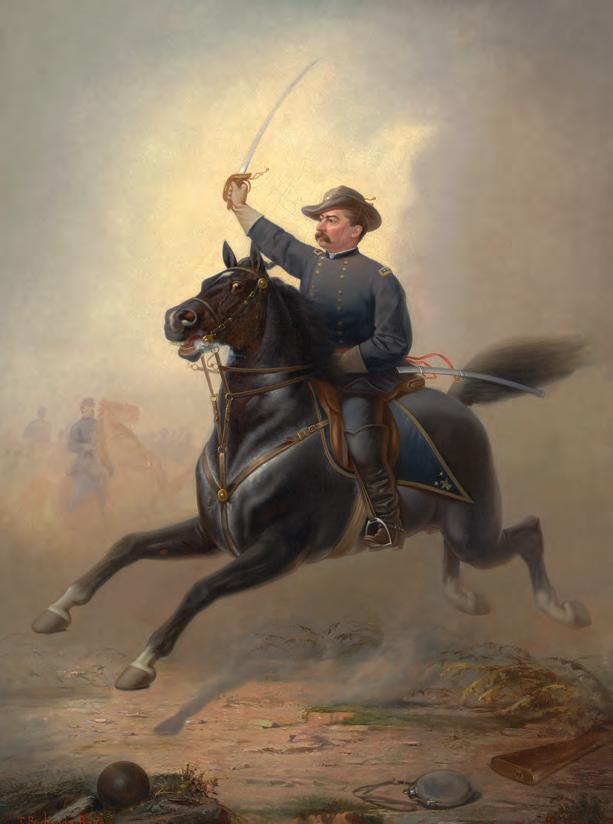
Two days after the battle, Brig. Gen. George Armstrong Custer, commanding a cavalry division in Sheridan’s army, and Brig. Gen. Frank Wheaton, a division commander in the army’s 6th Corps, addressed troops in the 15th New Jersey Infantry. Alanson Haines, the 15th New Jersey’s chaplain, recalled that men “rejoiced in victory” and “tried to cheer, but their hurrah was faint and weak.”
Juxtaposed against the backdrop of fresh graves, the 15th’s veterans weren’t feeling much elation. As Custer and Wheaton talked, in fact, Haines found himself transfixed on the grave of Sergeant John Mouder, the color-bearer of the unit’s state banner, killed during the morning’s fighting. “Just over the hill and almost in sight was the little mound which marked the spot where young Mouder slept,” Haines wrote. “His ear was deaf to the words of commendation… our best cheer failed to arouse his attention.” Gnawing at him was the perception that “the country was jubilant over Sheridan’s victory,” but “did not know and appreciate the sufferings of those who had won it.”
In the battle’s aftermath, other Union veterans reflected with similar somberness. Corporal Charles Shergur of the 9th New York Heavy Artillery recorded his thoughts after visiting his unit’s former campsite and finding a discarded
Smashed Hopes
A damaged 12-pounder case-shot shell recovered on the Cedar Creek battlefield. Jubal Early’s Confederates would lose an estimated 48 artillery pieces during the battle.

40 AMERICA’S CIVIL WAR LIBRARY OF CONGRESS NATIONAL PORTRAIT GALLERY;
PHOTO BY MELISSA A. WINN
ACWP-230400-CEDARCREEK.indd 40 12/13/22 8:55 AM
drum head. “I come to the very ground where my tent stood in the morning, but now I miss my tent-mate and comrade,” he would write. “I feel lonesome and utterly exhausted[,] I lie down on the ground. Victory was on our banner, but our comrades living and dead mingle together on the ground.”
Beyond such melancholy reflections, the army’s veterans also confronted the stark reality that Confederate Lt. Gen. Jubal Early likely wasn’t done yet. Despite bold statements from newspaper correspondents that Confederate forces in the Valley no longer posed a threat, the Federal soldiers did not feel so certain. As November approached, Corporal James Thatcher, also of the 9th New York Heavy Artillery, told his brother: “[W]e expect another hard fight at Cedar Creek within a short time.”
On October 27, Colonel Rutherford B. Hayes, who commanded a division in Sheridan’s army, wrote to his wife that he believed another attack possible, especially if Early hoped “to interfere with the election.” Three days later, Captain Charles Washington Kennedy, 156th New York Infantry, did the same in a letter to his wife, Kate: “There is a general impression that we will have another fight before we go into winter quarters.”
Cheerleader
In this Alfred Waud sketch, Brig. Gen. George Custer presents a set of captured Confederate flags to War Department officials on October 28, 1864. Custer, in trademark fashion, did what he could to buoy the spirits of stillanxious Army of the Shenandoah soldiers.
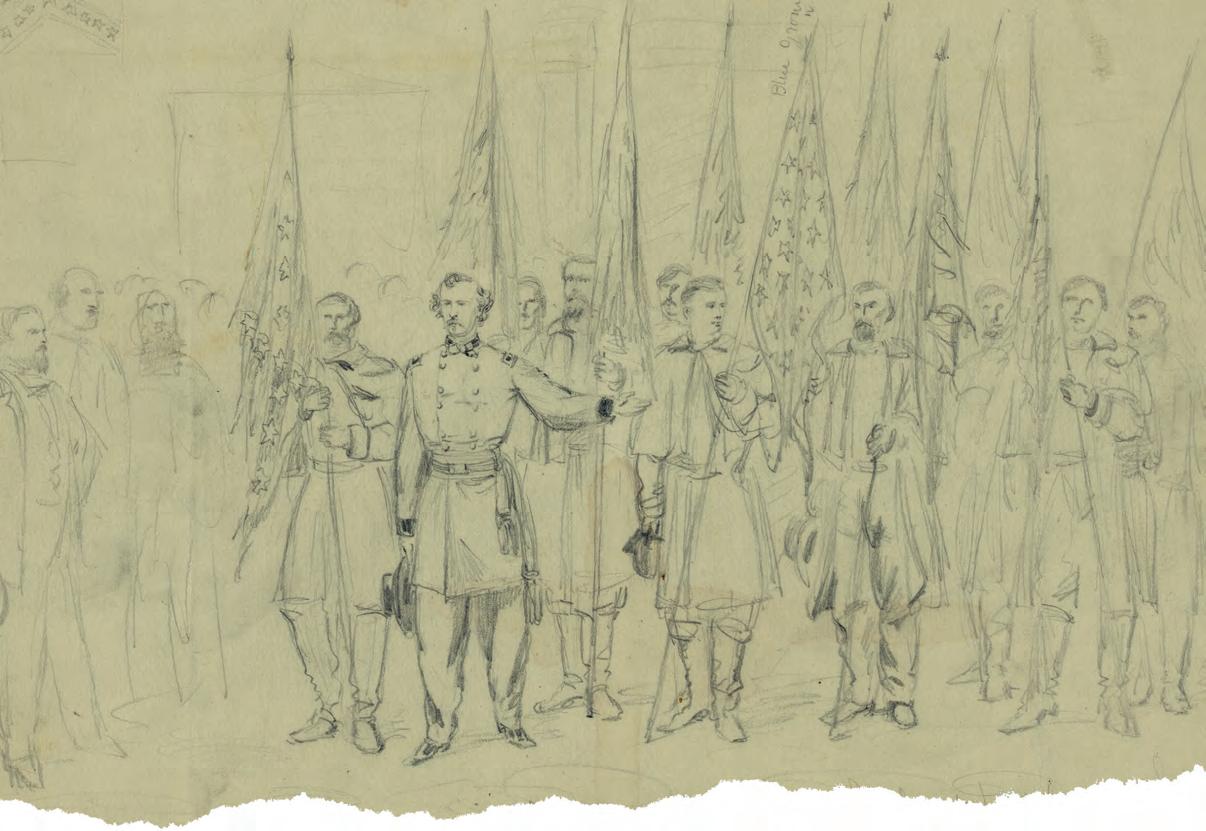
In Cedar Creek’s immediate wake, continued harassment from Confederate partisans, irregulars, and bushwhackers only added to the uncertainty. Sheridan had been particularly annoyed by “guerrilla bands” throughout the campaign. Though conceding he wouldn’t entirely eliminate all of the threats they posed, the general was confident these guerrillas could be curtailed by depriving them of potential manpower. On October 22, Sheridan ordered the arrest of every Confederate male civilian capable of bearing arms, a directive the region’s civilians understandably found unconscionable. Among the staunchest of Confederate supporters in Winchester was Mary Greenhow Lee, who declared it “an outrage for our citizens to be shut up in a horrid Yankee Guard House.”
Some of those called upon to enforce the edict had misgivings, too. Believing it would only further alienate the Confederate civilians population, Mason Whiting Tyler, an officer in the 37th Massachusetts Infantry, wrote his parents the day after Sheridan’s order: “The order has just been issued by General Sheridan for the arrest of all male citizens in the Valley…who are capable of bearing arms. It will cause such a commotion… as has not been seen since the war commenced.”
After a few days of arrests, Tyler lamented to his brother that arresting “citizens of disloyal tendencies”—including “some old men sixty or seventy years of age and much broken down with the infirmities of old age”—
SPRING 2023 41 LIBRARY OF CONGRESS NATIONAL PORTRAIT GALLERY;
PHOTO BY MELISSA A. WINN
ACWP-230400-CEDARCREEK.indd 41 12/13/22 8:55 AM
was “too relentless” and made him “uneasy.” Nevertheless, Tyler accepted that as much as he detested the practice, he possessed “no right to express an opinion.”
Sheridan soon had to heighten security even further after three unidentified Confederate soldiers recovering from wounds escaped from Winchester’s York Hospital. Mary Greenhow Lee, who regularly attended the wounded at the facility, had reportedly had a conversation with those three soldiers a day earlier and when informed of their plot had advised them against it. Lee unabashedly detested Sheridan and his army, but she also believed he would make life even more difficult for area inhabitants if they escaped, even pleading with one prisoner “not to go…knowing it would create a disturbance.”
As she feared, it did. Sheridan responded by intensifying the hospital’s guard and permitted no one to enter or leave without a pass. Further, Sheridan forbade local Confederate women from serving as nurses.
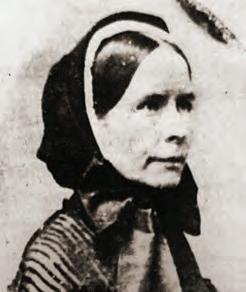
On the day of the escape, a contingent of Lt. Col. John Singleton Mosby’s vaunted Rangers captured seven wagons, 54 infantrymen, 30 mules, eight horses, and Union Brig. Gen. Alfred Duffié during a raid north of Winchester. A day
later, 44 soldiers of the 26th Massachusetts, commanded by 2nd Lt. Joseph McQuestion, were captured while guarding a forage train near Newtown—more than likely by another party of Rangers commanded by Captain Adolphus “Dolly” Richards, one of Mosby’s most trusted subordinates.
The Massachusetts soldiers were sent to prison camps in Richmond. Although most survived and were exchanged in February and March of 1865, three died in captivity: Charles F. Robbins, a farmer from Shirley; Simeon Ward, a bootmaker from Hopkinton; and Peter Alexander, a farmer from Wilmington.

Army of the Shenandoah soldiers were worried not only by the possibility of capture while escorting wagon trains, but also when they were detailed to guard civilian property. Because Sheridan prohibited the “seizure of property by Officers or Enlisted men of this Army” unless they possessed his “written authority,” Little Phil permitted civilians, regardless of allegiance, to request guards. Among those assigned to such duty was Private John Flint of the 116th New York Infantry. A 24-year-old farm laborer from Erie County, N.Y., Flint was detailed to protect the property of the Walls family in Newtown—a locality that had gained notoriety throughout the war as a safe haven for Confederate partisans, irregulars, and bushwhackers. Fearing he might be “betrayed” to Mosby’s men, Flint came across somewhat standoffish to the family matron, Mollie, in the assignment’s early days. His apprehension was no doubt warranted,
Keeping Their Guard Up
With Winchester again in Union control, blue-clad soldiers congregate outside the city courthouse. The vital city changed hands repeatedly throughout the war.
42 AMERICA’S CIVIL WAR
WEEKLY STEWART
WESTERN
HARPER’S
BELL JR. ARCHIVES, HANDLEY LIBRARY;
RESERVE HISTORICAL
ACWP-230400-CEDARCREEK.indd 42 12/13/22 8:55 AM
Mary Greenhow Lee
as the Walls had already entertained elements of Mosby’s command on various occasions.
Although she supported the Confederacy, Mollie Walls appreciated Flint’s presence in helping keep her family safe, particularly as supplies become more scarce with the approach of winter. Civilians could purchase any supplies they needed but were free to do so only with a permit from the Army of the Shenandoah’s provost marshal. The only way to procure one, Walls recalled, was “to take the oath of allegiance to the U.S.”—something she refused to do.
Requiring civilians to take an oath of allegiance had been an oft-used tactic to break civilians’ Confederate loyalties, yet many Valley locals had figured ways to circumvent the system, including playing on the sympathies of Union soldiers. On numerous occasions in November–December 1864, Flint would be the one to buy what the Walls “needed” from area sutlers and apparently did not expect reimbursement, even though Walls noted that the family “would always pay him back.”
In defeat, Early and his Army of the Valley retreated from Cedar Creek toward the crossroads town of New Market, site of a shocking Confederate victory back in May, before Sheridan had assumed command of what had been known as the Department of West Virginia and begun to reverse Federal fortunes in the so-called “Breadbasket of the Confederacy.” His army camped in the vicinity of New Market, Early was facing harsh criticism—reproach that only intensified after the general’s scathing indictment of his army appeared in The Richmond Enquirer on October 23.
Ever the Menace
Members of John Mosby’s Rangers lie in wait in the Blue Ridge Mountains. Despite a run of losses in the late summer and fall of 1864 that wrecked Confederate military hopes in the Valley, Mosby and his men remained a serious threat to Federal forces until the very end.
Early had publicly lambasted his command for plundering abandoned Union camps during the battle’s early hours. That, Early contended, had significantly slowed momentum and had singlehandedly reversed the promise of a Confederate victory. The Enquirer article—headlined “An Address from Gen. Early to His Troops”—echoed the report Early had sent to General Robert E. Lee on October 21. “By your subsequent misconduct, all the benefits of that victory were lost… ,” Early berated his troops. “Had you remained steadfast to your duty and your colors, the victory would have been one of the brilliant and most decisive of the war… But many of you…yielding to a disgraceful propensity for plunder, deserted your colors to appropriate to yourselves the abandoned property of the enemy.”
Artillerist Thomas Henry Carter was among those in Early’s command to denounce their commander. On October 26, Carter wrote his wife from New Market that though Early “has many good qualities of a soldier,” he “is no Genl. On the battlefield he is without particular aim or plan & the fighting under his control is languid.” Echoed George Nichols of the 61st Georgia: “We could not help but blame General Early for all the disasters at Cedar Creek… he never had the confidence of his men after [that].”
Indictments of Early also poured in from civilians in the Valley. Sarah L.
McComb, a resident of Augusta County, wrote to President Jefferson Davis calling for Early’s immediate removal from command. “[T]here will never be any thing but defeat & disaster until [he] is relieved...” McComb wrote. “[M]en & Senior officers have lost all confidence in their leader.”
Beginning November 8, Sheridan moved the Army of the Shenandoah from its camps along the banks of Cedar Creek north to the vicinity of Kernstown. With reconstruction work on the Winchester & Potomac Railroad nearing completion from Harpers Ferry to Stephenson’s Depot, it was a prudent move, as it improved Sheridan’s capacity to resupply his army.
By the second week of November, the Army of the Shenandoah indeed faced a severe supply crisis, particularly being able to provide enough hay for the army’s horses. The situation had

SPRING 2023 43 HARPER’S WEEKLY STEWART BELL JR. ARCHIVES, HANDLEY LIBRARY; WESTERN RESERVE HISTORICAL
ACWP-230400-CEDARCREEK.indd 43 12/13/22 8:56 AM
Elite Company?
Jubal Early’s alarming raid to the gates of Washington in July 1864 made him a household name in Confederate circles. By October, the fiery general had lost his own army with a scathing critique of their Cedar Creek efforts.
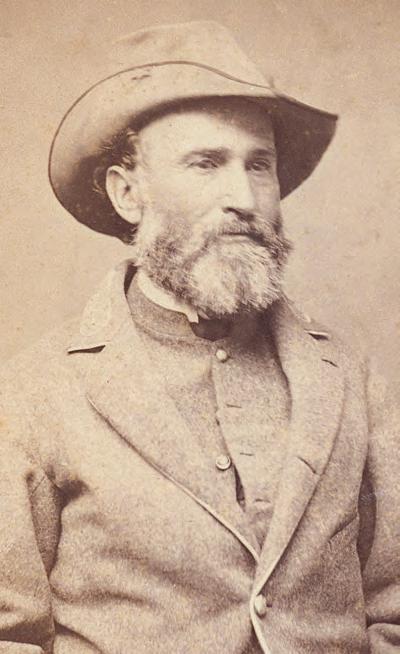
become so dire that Corporal Robert Bradbury, Battery D, 1st Pennsylvania Light Artillery, wrote his sister Harriet that “our horses had become so ravenous that they eat up most of the halter straps…spoiled about a dozen caisson wheels by eating clean through the spokes” and “whenever one horse could get at the tail of another he chawed all the hair off as clean as if it were a razor.” The sight of horses without tails, Bradbury noted, was “a most ludicrous spectacle.”
In addition to being able to better supply the army, Sheridan decided re-situating his army in the vicinity of Kernstown put him in a stronger defensive position and allowed Lt. Gen. Ulysses S. Grant, General in Chief of the Union Army, to pull reinforcements from Sheridan’s command as needed. Learning of Sheridan’s movement northward, Early was convinced it could mean only one thing, “that Sheridan was preparing to send troops to Grant.”
Lee had sent Early to the Shenandoah Valley in June 1864, determined for it to serve as a
diversionary theater of war, needed to keep as many Union troops away from hotly contested Petersburg as possible. With Sheridan’s army now on the move, Early realized he couldn’t stay put. On November 10, the Army of the Valley left its camps near New Market. Interestingly, that same day, a correspondent for The Indianapolis Star projected in an article that Sheridan’s army had not seen the last of Early—unaware of the Confederates’ movement. “Early stands tauntingly” before Sheridan, the correspondent observed. “The Confederate army, that has been again and again sent howling and whirling up the Valley,” could indeed pick up “the little pieces into which it was smashed” and strike.
As the Army of the Valley moved north, few in its ranks, if any, harbored delusions that this would result in a dramatic reversal of fortunes. At this point, the measure of success was not battlefield triumph, but the capacity to incite enough uncertainty among war-planners in Washington, D.C., about Confederate intentions in the Valley to prevent Sheridan from sending any troops to Grant’s aid east of the Blue Ridge Mountains. Brigadier General Bryan Grimes, a division commander in Early’s army, wrote to his wife before the departure from New Market: “We leave here to-day to demonstrate against the enemy, to cause them to return with the troops to prevent reinforcement of Grant. If we accomplish that, it will be all that can be expected of us.”
The following day, while Sheridan’s command labored on entrenchments and quarters at their new position, Camp Russell—named in honor of Union Brig. Gen. David Russell, killed at the Third Battle of Winchester (Opequon) on September 19—orders to “Fall in at once” sounded. As recalled by Major John Mead Gould of the 29th Maine, when Confederate soldiers appeared on their front, the mood of Sheridan’s veterans ranged from ambivalence to uncertainty. Acknowledging it was important to remain “alert,” Gould wrote that he “refused to be excited.” On the other hand, Francis Coffin, a veteran of the 30th Maine Infantry, didn’t share Gould’s nonchalance. He was convinced they “were to have another fight for the possession of the valley.”
Outside Camp Russell, however, there seemed little enthusiasm among Early’s men to engage Sheridan. As Confederate artillerist Thomas Henry Carter noted, the Army of the Shenandoah’s “strongly entrenched” position produced “a most uneasy feeling all down the line.” In all probability,
Symbol of Pride
This Union 6th Corps badge belonged to Private John B. Lucas, who saw action at Cedar Creek with Company I of the 67th Pennsylvania Infantry. A three-year veteran, Lucas survived not only Cedar Creek but the war, mustering out in June 1865.

44 AMERICA’S CIVIL WAR STEWART BELL JR. ARCHIVES, HANDLEY LIBRARY LIBRARY OF CONGRESS; HERITAGE AUCTIONS, DALLAS
ACWP-230400-CEDARCREEK.indd 44 12/14/22 10:26 AM
With Sheridan’s army now on the move, Early realized he couldn’t stay put.
Carter wrote, the Confederates “would have given way” had they been engaged by Sheridan’s troops.

Early’s and Sheridan’s soldiers did not come to blows that day, but Union and Confederate cavalry soon did. On November 12, troopers from Union Colonel Alexander Pennington’s brigade engaged portions of Maj. Gen. Thomas Rosser’s command along the Back Road. After a sharp fight, Rosser’s troopers were forced to “give way” and fled “in confusion across Cedar Creek.” Colonel William Powell’s cavalry brigade had similar success against Confederate Maj. Gen. Lunsford Lomax near Nineveh on the Winchester–Front Royal Pike. With his cavalry defeated on both his western and eastern flanks, coupled with the strength of Sheridan’s position, Early that night ordered his command to withdraw south.
Although the threat from partisans, irregulars, and bushwhackers would remain until the end of the war, once Early withdrew south without engaging Sheridan’s main force, soldiers in the Army of the Shenandoah were finally able to brim with confidence that Early no longer posed a threat. Early’s unwillingness to engage, coupled with deteriorating weather conditions in mid-November, prompted New Yorker Lewis Foster to write his mother confidently: “There is not much prospects of battle in the Valley this fall. The Johnnies have gone up the Valley.”
Five days after Early withdrew, Colonel Hayes again reached out to his wife: “When I wrote last I was in some doubt whether this Valley campaign was ended or not. It seems to be now settled. Early got a panic among his men and left our vicinity for good.”
Even though Early would remain in the Valley, the bulk of his command did not. On November 15, Maj. Gen. Joseph Kershaw’s Division headed to Petersburg. Three weeks later, the divisions commanded by Maj. Gen.
Security Blanket
After moving his army to Winchester, Sheridan established Camp Russell near Newtown, Va. (shown here in a Frank Leslie’s Illustrated Newspaper sketch) for added protection. In January 1865, he handed command of the garrison to venerable Brig. Gen. J.D. Fessenden.

John B. Gordon and Brig. Gen. John Pegram followed suit. By mid-December, Early’s command rested near Waynesboro, Va., its strength reduced to about 3,000 men.
George Carpenter, a veteran of the 8th Vermont Infantry, perhaps summed it up best. Until November 12, Carpenter wrote, Early “continued to menace the Shenandoah Valley as the sea lashes the shore after the fury of a storm is spent,” adding that from that point forward, “Old Jube” would “never again…touch the high water mark.”
Jonathan A. Noyalas is director of Shenandoah University’s McCormick Civil War Institute, a professor in the history department at Shenandoah, and the author of numerous books including Slavery and Freedom in the Shenandoah Valley During the Civil War Era (University Press of Florida, 2021).
SPRING 2023 45 STEWART BELL JR. ARCHIVES, HANDLEY LIBRARY LIBRARY OF CONGRESS; HERITAGE AUCTIONS, DALLAS
ACWP-230400-CEDARCREEK.indd 45 12/13/22 8:56 AM
Lee’s Last Hope
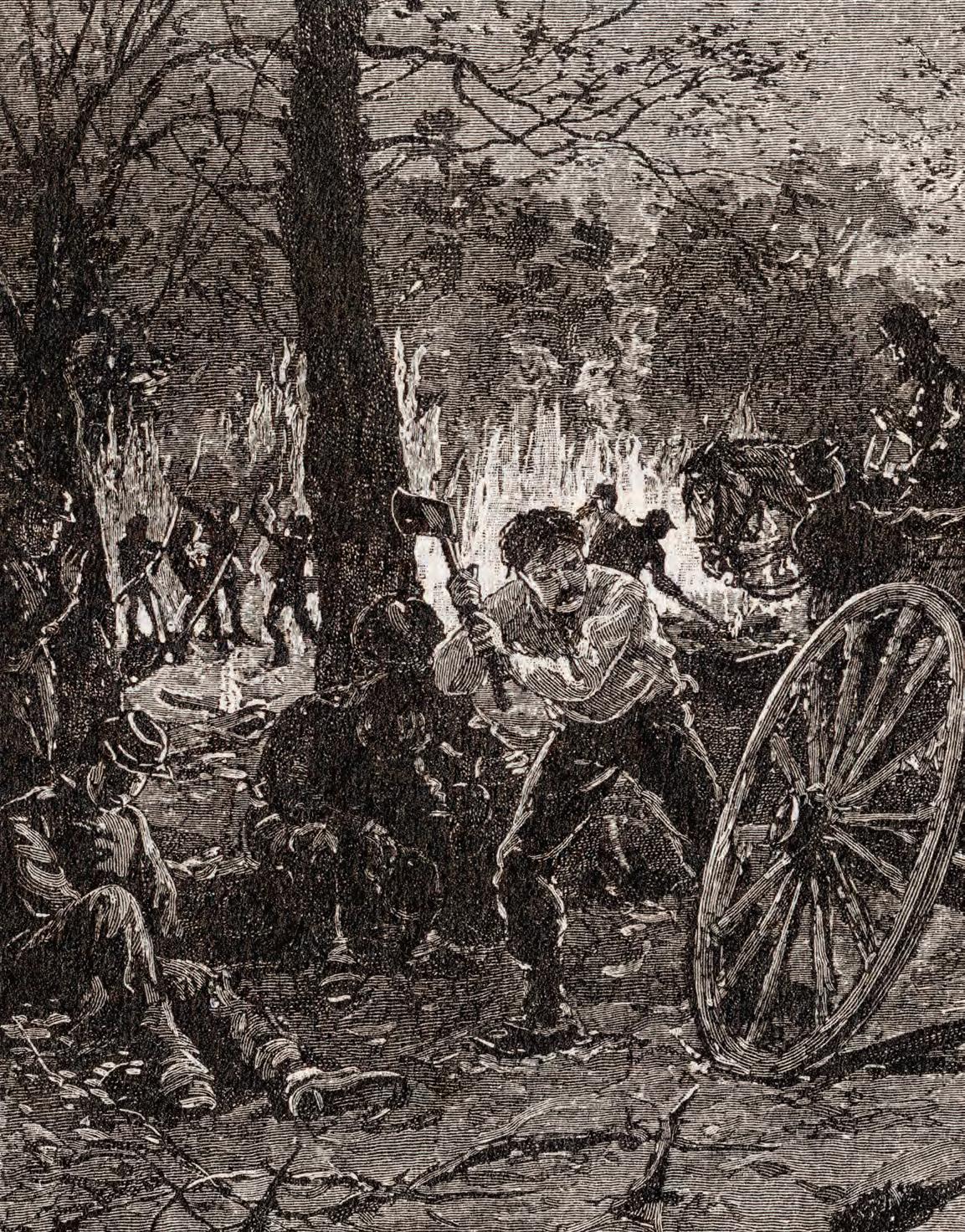
46 AMERICA’S CIVIL WAR
PHOTO CREDIT
ACWP-230400-PORTFOLIO.indd 46 12/13/22 9:05 AM
“Confederates Destroying the Railroad From Appomattox Toward Lynchburg, and Artillerymen Destroying Gun-Carriages, at Nightfall, Saturday, April 8” detailed the last days of the war and ran in the fourth volume of Battles and Leaders of the Civil War.
IlLustraToR ConfEderAcy of the
William
Ludwell
Sheppard gave countless Southern readers an intimate look at the war
 By Stephen Davis
By Stephen Davis
SPRING 2023 47
PHOTO CREDIT
ACWP-230400-PORTFOLIO.indd 47 12/13/22 9:06 AM
If you are familiar with Francis Trevelyan Miller’s Photographic History of the Civil War, you’re aware that wartime photographs were not published until shortly before 1911, when that monumental 10-volume work came out.
That explains why, when in the mid-1880s Richard Watson Gilder and Clarence Clough Buel conceived a multipart series on the war for Century Magazine, they turned to renowned illustrators such as Edwin Forbes, Theodore Davis, the Waud brothers… …and William L. Sheppard.
Born in Richmond in 1833, Sheppard joined the Richmond Howitzers and rose to lieutenant. After the war he resumed his art career, drawing for Harper’s Weekly, Frank Leslie’s Illustrated, and other magazines.
Among other works, his drawings are found in James Longstreet’s From Manassas to Appomattox (1896), Joseph Derry’s Story of the Confederate States (1895), and Carlton McCarthy’s Detailed Minutiae of Soldier Life in the Army of Northern Virginia, 1861-1865 (1882).
Most of us, however, know Sheppard’s work from Battles and Leaders—more than a dozen drawings.

“It is probably safe to say, there is no one who studies the American Civil War who has not seen the initials ‘W.L.S.,’” wrote Ulrich Troubetzoy in an appreciation that appeared in the December 1962 issue of Civil War Times Illustrated

Sheppard was also a watercolorist. Iconic images depict a Confederate infantryman, cavalryman, and artilleryman, as Sheppard remembered them through the years. (Note that many of Sheppard’s Rebels sport goatees, which was the hirsute adornment the artist himself adopted postwar.)
Other watercolors are today to be seen in Richmond’s American Civil War Museum, among them: “Opening Spring Campaign in Valley of Virginia”; “Newspapers in the Trenches ’64”; and “Company Q. Stragglers.” The Virginia Museum of History and Culture, also in Richmond, holds a unique collection of Sheppard illustrated cartes-de-visite.
Sheppard made Richmond his home after the war. He died in 1912 and is buried in Hollywood Cemetery.
Among his most noted achievements was his design for the oft-pictured statue to the Richmond Howitzers that was cast by Caspar Buberl. It stood at Park Avenue and Harrison Street in the Virginia capital until torn down during citywide protests in 2020.
It may be gone, but as Ms. Troubetzoy wrote decades ago, “W.L.S.” will be initials on illustrations that Civil War enthusiasts will be recognizing for years more to come.
Stephen Davis, an ACW Advisory Board member, writes from Cumming, Ga. He is co-author, with Bill Hendrick, of The Atlanta Daily Intelligencer Covers the Civil War (University of Tennessee Press, 2022).
A Somber Salute
After General Robert E. Lee met Union Lt. Gen. Ulysses S. Grant in Wilmer McLean’s parlor to surrender the Army of Northern Virginia at Appomattox, word quickly spread through the Confederate ranks. Lee was met with an emotional reunion with his men when he returned to the lines afterward. “General,” some men cried, “are we surrendered?” Sheppard recorded Lee’s return in an on-the-spot sketch from which this Century Magazine engraving was made. It was later included in the Battles and Leaders of the Civil War series.

48 AMERICA’S CIVIL WAR THIS PAGE: BATTLES AND LEADERS OF THE CIVIL WAR (2) PREVIOUS PAGE: BATTLES AND LEADERS OF THE CIVIL WAR
ACWP-230400-PORTFOLIO.indd 48 12/13/22 9:06 AM
Battle Scars
Sheppard’s “Counting the Scars in the Colors” ran in Battles and Leaders alongside a personal account of the first day of the Battle of Gettysburg by E.P. Halsted, Brevet Major and Assistant Adjutant General of the U.S. Army of Volunteers. “The advantages of position were, perhaps, favorable to us, but in numbers the enemy was vastly superior,” Halsted recalled.

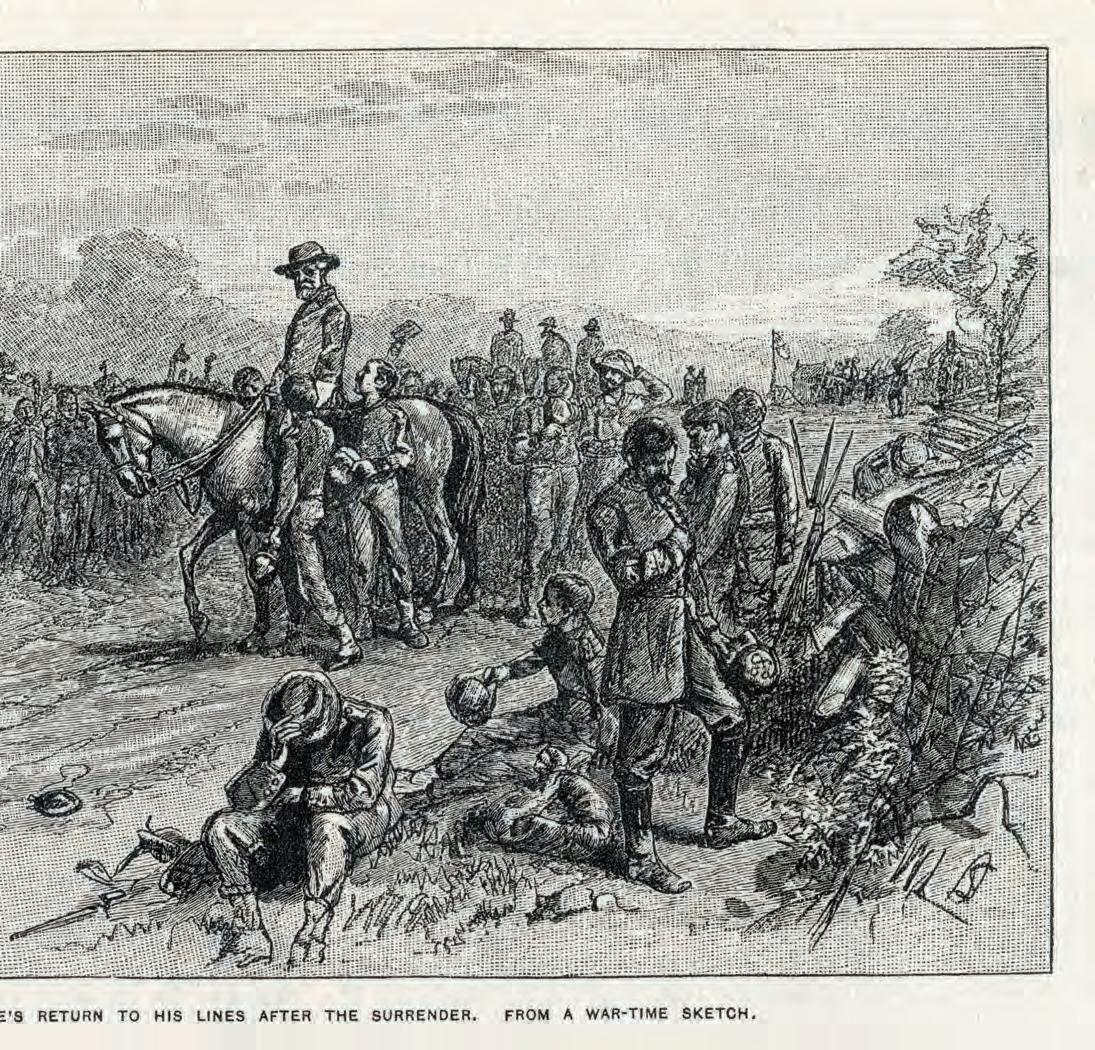
SPRING 2023 49 THIS PAGE: BATTLES AND LEADERS OF THE CIVIL WAR (2) PREVIOUS PAGE: BATTLES AND LEADERS OF THE CIVIL WAR
ACWP-230400-PORTFOLIO.indd 49 12/14/22 8:34 AM
A Game of Chase
When cheering erupted in one of Lee’s Army of Northern Virginia camps, soldiers quipped that it must be “Old Jack” (i.e., Stonewall Jackson) or a rabbit. Here, in Sheppard’s “A Rabbit in a Confederate Camp,” starving Confederates chase down a hare for food.

Sheppard’s drawings helped illustrate not just battle lines and action, but the everyday realities of soldiers in camp.
Pocket Album
Sheppard’s illustrations were also printed on cartes-devisite and sold in sets of 10, each card with a different scene from the war. This one depicts Confederates in camp in 1861 enjoying the company of guests and a fine meal served by an African American. The title was “Good Times 1861,” noting that the spoils didn’t last.

50 AMERICA’S CIVIL WAR
STORY OF THE CONFEDERATE STATES BATTLES AND LEADERS OF THE CIVIL WAR BATTLES AND LEADERS OF THE CIVIL WAR ; VIRGINIA MUSEUM OF HISTORY AND CULTURE
ACWP-230400-PORTFOLIO.indd 50 12/13/22 4:25 PM
Of
Church and State
A Formidable Position
“The 29th Pennsylvania Forming Line of Battle on Culp’s Hill at 10 a.m., July 3” ran in Battles and Leaders of the Civil War, accompanying Union Brig. Gen. Henry Hunt’s article, “The Third Day at Gettysburg.” During the Battle of Gettysburg, the 29th lost 14 killed and 3 mortally wounded, including Sgt. Maj. Charles H. Letford. Wounded by a shell in the abdomen, he died July 3.
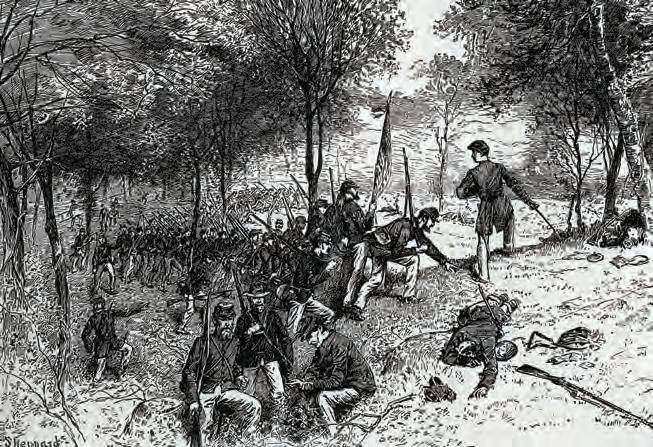


STORY OF THE CONFEDERATE STATES BATTLES AND LEADERS OF THE CIVIL WAR BATTLES AND LEADERS OF THE CIVIL WAR ; VIRGINIA MUSEUM OF HISTORY AND CULTURE SPRING 2023 51
“Distributing Tracts in the Trenches” appeared in Joseph T. Derry’s Story of the Confederate States. Its distinctly proSouthern perspective is shown by such statements as Derry’s claim that “the Confederate soldiers....fought only for home and loved ones and the liberty of the South.”
ACWP-230400-PORTFOLIO.indd 51 12/13/22 9:07 AM
Surprise Attack
Stonewall Jackson’s renowned flank march during the May 1863 Battle of Chancellorsville allowed Southern troops to storm and overwhelm Maj. Gen. O.O. Howard’s 11th Corps. Sheppard catches the moment of surprise in “The Confederates Charging Howard’s Breastworks” which ran in the Battles and Leaders of the Civil War series.

Incoming
In June 1864, during the Atlanta Campaign, the armies of Generals Sherman and Johnston hunkered in trenches near Kennesaw Mountain amid skirmishing and cannonading. When a Northern shell landed in a Confederate trench, Sergeant Isaac Collier of the 5th Georgia picked up the smoking shell and threw it out of the ditch. The tale of Collier’s bravery made it into Southern newspapers and the postwar literature, inspiring this Sheppard drawing.
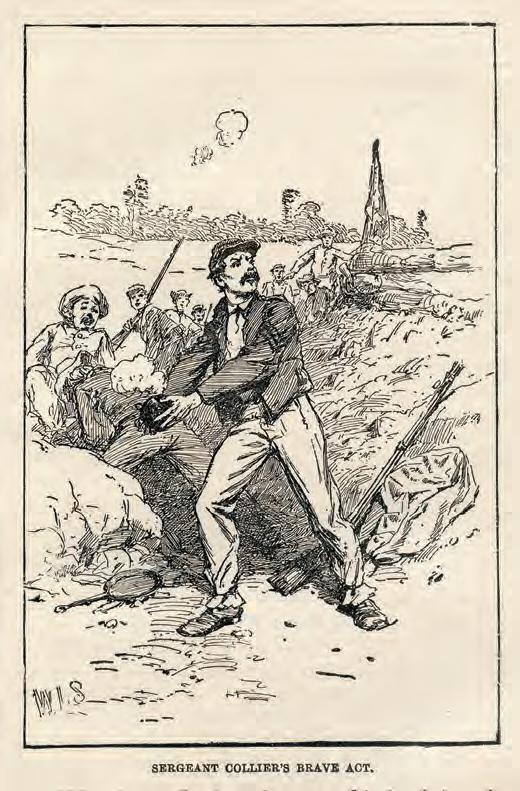
52 AMERICA’S CIVIL WAR
DETAILED MINUTIAE OF SOLDIER LIFE IN THE ARMY OF NORTHERN VIRGINIA BATTLES AND LEADERS OF THE CIVIL WAR BATTLES AND LEADERS OF THE CIVIL WAR ; STORY OF THE CONFEDERATE STATES
ACWP-230400-PORTFOLIO.indd 52 12/13/22 9:07 AM
Closing Remarks
“Last Shot. Sailor’s Creek” appeared in Carlton McCarthy’s Detailed Minutiae of Soldier Life in the Army of Northern Virginia. During the war, McCarthy (1847-1936) served in the Richmond Howitzers. In the 1870s, he wrote sketches of soldier life for the Southern Historical Society Papers, a monthly magazine published in Richmond. From them he assembled Detailed Minutiae, which appeared in 1882. It carries 29 images, all by Sheppard.
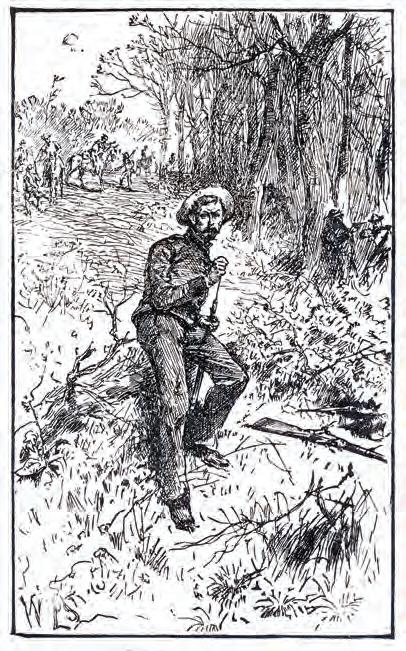
Hail to the Chief
Confederates abandoned Richmond on April 2, 1865. Two days later, Lincoln traveled up the James River by steamer and landed ashore. Riding into the city, the president was cheered by citizens—mostly newly freed slaves, as shown here in Sheppard’s “President Lincoln Leaving the Davis Mansion.” This illustration also ran in the Battles and Leaders series.

SPRING 2023 53 DETAILED MINUTIAE OF SOLDIER LIFE IN THE ARMY OF NORTHERN VIRGINIA BATTLES AND LEADERS OF THE CIVIL WAR BATTLES AND LEADERS OF THE CIVIL WAR ; STORY OF THE CONFEDERATE STATES
ACWP-230400-PORTFOLIO.indd 53 12/13/22 9:07 AM
Devil’s Dare
On December 31, 1862, the same day the much-bloodier Battle of Stones River raged to the east in Murfreesboro, Tenn., 1,800 Confederate cavalrymen under Nathan Bedford Forrest fought two Union brigades of Midwesterners at the hamlet of Parker’s Crossroads. In the preceding days, Forrest’s aim had been to disrupt Union supply lines in West Tennessee and Mississippi.
Steve McDaniel, a battlefield guide and longtime city manager. McDaniel is a lifelong Parker’s Crossroads resident whose family roots in the area date to 1820.
Trailside is produced in partnership with Civil War Trails Inc., which connects visitors to lesserknown sites and allows them to follow in the footsteps of the great campaigns. Civil War Trails has more than 1,400 sites across six states and produces more than a dozen maps. Visit civilwartrails.org and check in at your favorite sign #civilwartrails.
The battle resulted in roughly 750 casualties and almost the capture of Forrest, who ended up burnishing his reputation in this unheralded fight. Both sides claimed victory, but the battle is considered a Confederate triumph.
In the late 1960s, the construction of Interstate 40 bisected the battlefield, which today is maintained by the town of Parker’s Crossroads. Of the 1,400 acres encompassing the battlefield, 370 acres are preserved— all core hallowed ground, according to

Battlefield walkers can explore four miles of paved trails and examine more than 50 interpretive markers in park areas on the north and south sides of the interstate. No historic homes remain standing on the battlefield.
About 85 miles west of Nashville, this remains a small town (pop. 284). From Parker’s Crossroads, visitors can travel to the Shiloh and Fort Donelson battlefields, each a little more than an hour’s drive away, or visit nearby Jackson, Tenn., where Forrest’s cavalry clashed earlier in December 1862 with Federal soldiers stationed at Salem Cemetery. For Civil War Trails sites to see in Jackson, visit historynet.com/ jackson-tenn. —John Banks
54 AMERICA’S CIVIL WAR TRAILSIDE
PHOTOS BY JOHN BANKS
(4)
PHOTO BY JOHN BANKS
FORREST’S HABIT OF FRUSTRATING THE FEDERALS WAS ON DISPLAY IN A NEW YEAR’S EVE CLASH HERE ACWP-230400-TRAILSIDE.indd 54 12/12/22 12:29 PM
Parker’s Crossroads, Tenn.
Hicks Field: Where the battle began
The orange triangle on this tree marks the general area where Forrest witnessed the discharge of Sergeant Nat Baxter’s mountain howitzer in the early stages of the battle. A shot from the weapon killed several 7th Wisconsin Artillery Battery soldiers about a quarter mile away. Scores of bullets, shell fragments, and other battle relics have turned up in this field over the years. The great-grandson of John Parker, the town’s namesake, told McDaniel he used Minié balls he found on the battlefield as fishing weights.
Visitor Center

A short distance off Exit 108 on Interstate 40 stands the small battlefield visitor center and museum. A display inside includes the Colt Model 1860 .44-caliber revolver of 3rd Tennessee Private Gideon Richardson (CSA), who suffered a mortal wound at Parker’s Crossroads, as well as a replica of a mountain howitzer used by Forrest’s troops. Visitors can watch an 18-minute movie about the battle in the museum. Outside, a Civil War Trails marker explains the action.

Rev. John Parker House Site

Parker’s house, which no longer stands, and his surrounding fields and nearby orchard became the vortex of the battle. A slave holder and Baptist minister, Parker farmed cotton, corn, and tobacco. In the chaos of battle near the house, a U.S. soldier held Forrest at gunpoint and demanded his surrender. The wily Forrest told the Federal he had already surrendered and his men were stacking arms near the house. A trace of the old LexingtonHuntingdon Road—a vital battlefield route—can still be seen nearby.
“Charge ’em both ways!”
In this field, on the north end of the battlefield park, Forrest supposedly uttered his famous four words when caught between Union brigades: “Charge ’em both ways!” Years ago, an archaeological survey in these fields turned up nothing but a piece of ancient pottery. “Bodies are out here,” McDaniel insists about battle casualties, “but we just don’t know where they are.”
John Parker’s grave in Jones Cemetery
A Unionist before the war, Parker died in 1864. His wife, Rebecca, died in 1871 and was buried next to him. The Rev. Parker supposedly switched allegiance to the Confederacy after a U.S. officer refused to move artillery placed in his yard during the battle. The Parkers’ graves are the only ones facing north in the cemetery. According to family lore, the doctor wanted to be buried facing that direction so he could kick the Yankees back home upon his call to heaven.

SPRING 2023 55
PHOTOS BY JOHN BANKS (4)
TRAILSIDE
PHOTO BY JOHN BANKS
ACWP-230400-TRAILSIDE.indd 55 12/12/22 12:29 PM
Burial site for Union soldiers
This gray-granite slab in a strip of woods near Interstate 40 denotes the location of a burial site for Union fallen. Two years after the war, remains were exhumed for reburial in a national cemetery in Corinth, Miss. In 1993, an archaeological excavation uncovered remains of a soldier as well as a piece of blue wool. More bodies probably remain. “You don’t know where you’ll find a body out here,” McDaniel says. “It’s all hallowed ground.”

Tennessee State Veterans Cemetery
Near Jones Cemetery is a cemetery for 21st-century interments of veterans. But this burial ground has a connection to the Civil War, too. A Texas man had a marker placed here in memory of Addison H. White, who served in the 13th Tennessee Cavalry (U.S.). On April 12, 1863, he was killed at Fort Pillow, near Memphis, Tenn. White’s burial site is unknown.
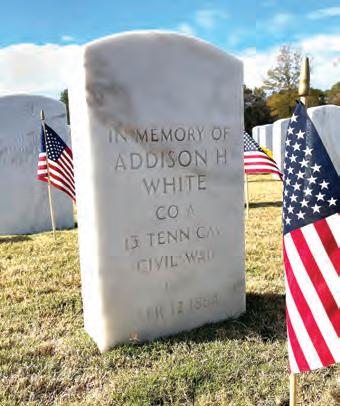
Confederate artillery position

From this site on the south end of the battlefield, Confederate artillery enfiladed the U.S. Army line. It’s a battlefield interpretive area in a neighborhood of modern houses today. Years ago, a metal detectorist unearthed friction primers for artillery here. At the dedication of the battlefield in 2006, the concussion of a replica cannon fired at the interpretive area toppled a dogwood.
B.E. Scott Bar-B-Que

10880 US-412, Lexington
After a trek around the battlefield, grab a bite at “the best at Parker’s Crossroads,” according to one reviewer. B.E. Scott was founded in 1962 to “make the best whole hog hickory smoked pit barbeque anywhere.” You can be the judge!

56 AMERICA’S CIVIL WAR TRAILSIDE
PHOTOS BY JOHN BANKS (3); COURTESY OF B.E. SCOTT’S BBQ
B.E. Scott
ACWP-230400-TRAILSIDE.indd 56 12/12/22 12:29 PM
Parker’s Crossroads Battlefield








BBQ Pin-Ups For Vets raises funds to better the lives and boost morale for the entire military community! When you make a purchase at our online store or make a donation, you’ll contribute to Veterans’ healthcare, helping provide VA hospitals across the U.S. with funds for medical equipment and programs. We support volunteerism at VA hospitals, including personal bedside visits to deliver gifts, and we provide makeovers and new clothing for military wives and female Veterans. All that plus we send care packages to our deployed troops. Alicia, Army Veteran visit: pinupsforvets.com PIN-UPS FOR VETS Supporting Hospitalized Veterans & Deployed Troops Since 2006 Gina Elise’s A conversational approach to interpreting history! Listen as hosts Patrick and Matt connect you with your favorite stories from the past— as well as ones you may have never heard! Download or listen for FREE @TheHistoryThingsPodcast CHECK OUT EDITOR IN CHIEF DANA SHOAF’S EPISODES ON GEN. ERASTUS TYLER AND AN 1861 MURDER IN MARYLAND! HISTORYTHINGSPODCAST-AD.indd 94 12/12/22 12:41 PM ACWP-230400-TRAILSIDE.indd 57 12/12/22 12:42 PM
PHOTOS BY JOHN BANKS (3); COURTESY OF B.E. SCOTT’S
Rocky Road
An underlying factor in the Confederacy’s eventual loss of the Civil War was President Jefferson Davis’ often-shaky ties to his generals. Nowhere was that more evident than Davis’ rocky partnership with Joseph E. Johnston. At the onset of the war, Johnston was in the middle of a tug of war between his native Virginia and the new Confederate government. When Davis began doling out promotions for some of his top officers, however, once-cordial relations turned sour for Johnston and his new commander in chief. Unfortunately, that animosity continued throughout the war. To his credit, Davis kept the proud Virginian in the command mix until the end. From the war’s first major engagement at Manassas, Va., to his surrender of the remnants of the Army of Tennessee in late April 1865, Johnston remained at the forefront of the war effort.
For his latest book, The Civil Wars of Joseph E. Johnston, Confederate States Army: Volume 1: Virginia and Mississippi, 1861-1863 (Savas Beatie, $34.95), esteemed historian Richard M. McMurry scoured resources in archives across the country for rare material. The result is an insightful look at one of the war’s more intriguing characters.

Struck Down in More Ways Than One
During the furious fighting at Seven Pines (above), Joe Johnston suffered two wounds and was incapacitated for months. As fate would have it, Robert E. Lee stepped into the vacated command and never relinquished it.

1Joe Johnston has been the focus of a great deal of literature already. What new material were you able to find?
Well, I found some diaries and letters that had not been used before, as well as many newspapers. The most important collection of letters that I found were those of Lieutenant Richard Manning, who served on Johnston’s staff from 1861 to 1863. He had many interesting insights into Johnston’s interactions and feelings, especially toward Generals Leonidas Polk and John Pemberton. He was not a big fan of either, but especially not partial to Pemberton.
58 AMERICA’S CIVIL WAR
THE HISTORY COLLECTION/ALAMY STOCK
5 QUESTIONS
PHOTO ALAMY STOCK
PHOTO; COURTESY OF SAVAS BEATIE
Interview by Richard H. Holloway
ACWP-230400-5Qs.indd 58 12/12/22 11:15 AM
Another source I stumbled across was that of Sue Harper Mims. She was married to Livingston Mims, who was on Johnston’s staff during the war and subsequently his business partner afterward. I also had a young man at the Mississippi Department of Archives who led me to the journal of Thomas B. Mackall. He was an aide and cousin of General William W. Mackall, who served on Johnston’s staff. That journal contained some great gems about Johnston.
2How quickly did the relationship between Johnston and Jefferson Davis unravel?
The animosity between Johnston and Davis began the moment Johnston joined the Confederate Army. The date was September 1861, and it began over Johnston feeling devalued at the rank Davis bestowed upon him. Many of his fellow officers were given a higher rank. But Johnston had already begun arguing with the Confederate government officials upon his assignment to command at Harpers Ferry, Va., back in May of 1861. At that point, many of those government officials drew Johnston’s ire, but Johnston did not yet have any friction with Davis.
3You discovered new information about the wounds Johnston suffered at Seven Pines and beyond. Explain.
Johnston was wounded twice at Seven Pines. He was shot both in the chest and in the shoulder, both painful and serious wounds. All of mid-1862, Johnston was unable to perform any military duties, either on the field or at a desk. When it seemed Johnston had finally recovered from his wounds in November 1862, he was injured yet again. This little-known incident occurred on a train ride between Atlanta and Montgomery, Ala. His rail car ran off the tracks, rolled over and slammed against a tree. Johnston was slung across the car and landed on top both Lieutenant Manning and a member of Patrick Cleburne’s staff. This definitely reaggravated his healing wounds from Seven Pines. Johnston also became very sick in the spring of 1863, about when he was sent to Mississippi. That was partially due to his wounds; the rest was the result of the normal diseases rampant at that time.
4What was the reasoning behind Davis’ decision to hand Johnston such a lofty command in the West in 1863?
Davis appointed Johnston to Western Theater command to provide direction to both Pemberton and Braxton Bragg. Remember, Johnston disliked Pemberton, and it only grew worse when he came into close contact with him. Johnston actually liked Bragg at this juncture, from 1862 to 1863. He had reason not to. Johnston’s resentfulness of Bragg came only after he replaced him as commander of the Army of Tennessee. At this point, Bragg was appointed to Davis’ administration, which was sufficient enough to draw Johnston’s scorn. Bragg also eventually came to resent Johnston taking his place in command of the Western forces. Johnston had friction, too, with William Hardee, Bragg’s interim replacement. He felt Hardee was fine as a division or corps commander, but nothing higher.

5How do you feel Johnston handled matters in the eventual loss of Vicksburg? Where did things stand for him as 1863 ended?
Vicksburg could not have been saved and Pemberton was wary of abandoning it. Vicksburg was so messed up, nothing could
Houdini Would Be Proud
Notable escapes by a supposedly trapped Johnston twice threw a wrench into Union plans in 1861-63. One, at Winchester, Va., led to victory at First Manassas; the other came at Jackson, Miss., in July 1863.
have been done to save it or its garrison. Johnston should have just specifically ordered Pemberton to leave the city entirely. Pemberton’s brief departure from Vicksburg was not in full force and he was quickly defeated at Champion Hill and removed his forces back to the trenches again. Nothing could have been done to wrest the city from Federal forces by the time Johnston arrived on the scene.
As for his besieged troops in Jackson, Johnston was totally unprepared to stay there. He had no supplies for a siege and would have starved and had to surrender the city just like Pemberton eventually had to do at Vicksburg.
Johnston ended 1863 at the Huff House, his headquarters in Dalton, Ga. He would go on to jump start the Army of Tennessee into an effective fighting force again as the calendar turned to 1864. Volume 1 of my book mainly covers Johnston’s feud with Davis and his administration and his time in the West.
To read the full interview, go to historynet.com/JoeJohnston1861-63
SPRING 2023 59 5 QUESTIONS THE HISTORY COLLECTION/ALAMY STOCK PHOTO ALAMY STOCK PHOTO; COURTESY OF SAVAS BEATIE
ACWP-230400-5Qs.indd 59 12/12/22 11:15 AM
Imperfect Man’
Spiritual Awakening
Jon Meacham is one of the nation’s most engaged, and engaging, public intellectuals. A Pulitzer Prize–winning presidential biographer, he possesses a rare ability to relate the American past to current circumstances in the service of informed, yet gentle advocacy.
Having already written major works on, among others, Thomas Jefferson and Andrew Jackson, Meacham’s turn to Abraham Lincoln seems like a welcome inevitability. His And There Was Light: Abraham Lincoln and the American Struggle is an elegantly argued life of our 16th president tailor-made for the contemporary moment.

While it may seem counterintuitive to suggest that a narrative of 421 pages is lean, that description suits And There Was Light. This is not a biography to turn to when delving into the machina tions of Lincoln’s Cabinet, the intimacies of the Lincoln household, or his search for a trustworthy military leader. Meacham has obviously made the calculation that others have covered these and other related topics in exhaustive detail.
Instead, his book “charts Lincoln’s struggle to do right as he defined it within the political universe he and his country inhabited.” A “morally imperfect” man, Lincoln nevertheless possessed “a prag matic vision with a moral component” that provided a guide star for his public life. Undeniably ambitious, the future president struck a political balance that lent him legitimate credentials as a reformer while maintaining a moderate
And There Was Light: Abraham Lincoln and the American Struggle
By Jon Meacham
Random House, 2022, $40
tone that avoided alienating potential supporters opposed to radical abolitionists.
The place religion plays in our political life has long been on Meacham’s radar, and he digs deeply here into Lincoln’s interior spiritual world. Over time, he argues, Lincoln’s view of the divine evolved from that of a remote deity to one bound up with the human drama. “The mature Lincoln,” he writes, “viewed the history of the American people and nation as mysteriously but inexorably intertwined with the will and the wishes…of a divine force beyond time and space.”
Despite his skepticism about human agency in the face of such a force, Lincoln was determined to play a role. As the war progressed, the embattled president came to believe that Providence had made him the Lord’s instrument to save the Union and in the process end slavery. Willie’s death in February 1862, Meacham suggests, only deepened the grieving father’s engagement with the divine, leading to a new level of personal religious inquiry.
But Lincoln’s thinking would have felt alien to most of his conventionally religious contemporaries. “To Lincoln,” Meacham writes, “God whispered His will through conscience.” He refused the possibilities of compromising with slavery, first on the eve of his taking

60 AMERICA’S CIVIL WAR
‘An
REVIEWS CLASSIC IMAGE/ALAMY STOCK PHOTO ACWP-230400-REVIEWS.indd 60 12/12/22 12:28 PM
President Abraham Lincoln was no saint, according to biographer Jon Meacham, but his life’s work was driven by a desire to do what was “right, just and morally sound.”
office and then during the 1864 campaign, “because he thought it was the right, just, and morally sound thing to do…. His insight on the wrongness of slavery,” the author concludes, “came more from an intuitive moral sensibility and a conviction that there were universal goods to be discerned and acted upon” than from any embrace of traditional Christianity.
Any treatment of Lincoln must wrestle with his views on slavery. “To chart Lincoln’s lifelong moral and political course on slavery and equality,” Meacham observes, “is not to sing his praises as if he were the hero of an epic poem.” He was not such a hero. But early in the book, Meacham reminds readers that while a native southerner, Lincoln grew up among people who held antislavery beliefs and pursued an evangelical faith at a time when that meant embracing emancipationist impulses.
While his pursuit of emancipation was shaped by his belief in what the Constitution did and did not permit him to do and moved at a pace that frustrated most abolitionists, no less a critic than William Lloyd Garrison came to write: “Yet what long strides he has taken in the right direction, and never a backward step.” As a creature of his time and place, Meacham contends, Lincoln would come to argue eloquently that Black Americans possessed all the natural rights outlined in the Declaration of Independence, and yet likely went to his grave believing that White racial prejudice would prevent Whites and Blacks from living among one another harmoniously.
Meacham makes much of Lincoln’s ability to grow during his presidency, including examples of his contemporaries recognizing and applauding this trait. One week before his death, the activist and writer Lydia Maria Child, heretofore a harsh critic, observed: “With all his deficiencies, it must be admitted that he has grown continuously…[and] it was great good luck to have the people elect a man who was willing to grow.”
Meacham closes with an astute, and emotionally moving, summation of Lincoln and his importance. “Lincoln was not all he might have been—vanishingly few human beings are—but he was more than many men have been.” No saint, he continues, Lincoln was “an imperfect man seeking to bring a more perfect Union into being.” That task required “an understanding that politics divorced from conscience is fatal to the American experiment.”
This was a lesson for Lincoln’s time, and surely, Meacham insists, one for our own. Rick Beard
A PREFERENCE FOR OFFENSIVE OPERATIONS was one of the defining characteristics of Robert E. Lee’s generalship. In light of Northern superiority in manpower and the resources for waging large-scale conventional operations in the industrial age, Lee believed the war needed to be kept away from his capital and that the Confederate cause was best served by operations that played to his army’s superiority at maneuver warfare. Circumstances during the first five months of 1863, however, denied Lee the opportunity to act in line with his preferences. Despite his Chancellorsville victory in May, Lee recognized he had benefited from exceedingly good fortune and the losses inflicted were unacceptably heavy. In June, his army reinforced, Lee ordered his legions to move west to the Shenandoah Valley, launching the great campaign that would produce the monumental threeday battle at Gettysburg.
“If We Are Striking for Pennsylvania”: The Army of Northern Virginia and the Army of the Potomac March to Gettysburg, Volume 1: June 3-21, 1863

By Scott L. Mingus Sr. and Eric J. Wittenberg Savas Beatie, 2022, $34.95
In this—the first in a multivolume study of the opposing armies’ maneuvers leading up to Gettysburg and the responses both sides received from civilians—Scott L. Mingus and Eric J. Wittenberg chronicle events up to June 21. At that point, the bulk of one of Lee’s corps had entered Maryland, while a force commanded by Brig. Gen. Albert Jenkins had probed across the Mason-Dixon Line and brought war to residents of the Cumberland Valley. Lee’s other two infantry corps were in the Shenandoah Valley, while Union and Confederate cavalry recuperated from clashes at Aldie, Middleburg, and Upperville, and the Army of the Potomac occupied positions between Fairfax Court House and the Bull Run Mountains from which it could defend Washington, D.C.
Readers looking for a detailed and wide-ranging, yet lively account of the movements that brought the two armies from the banks of the Rappahannock River to these positions will be well-served by Mingus and Wittenberg’s study. They will especially appreciate the clear, well-constructed maps that accompany the text and the skill with which the authors chronicle the cavalry clashes at Brandy Station and in the Loudoun Valley that took place in the course of the armies’ initial maneuvers for advantage on the road to Gettysburg. —Ethan S. Rafuse

SPRING 2023 61 REVIEWS
CLASSIC IMAGE/ALAMY STOCK PHOTO ACWP-230400-REVIEWS.indd 61 12/12/22 12:28 PM
Hearts Torn Asunder: Trauma in the Civil War’s Final Campaign in North Carolina
 By Ernest A. Dollar Jr. Savas Beatie,
By Ernest A. Dollar Jr. Savas Beatie,

2022, $32.95
IN THIS WELL-WRITTEN and superbly researched book, Ernest A. Dollar explores Maj. Gen. William T. Sherman’s bloody and decisive chess match against General Joseph E. Johnston in the war’s waning days in North Carolina—primarily how Southern soldiers reacted physically, psychologically, and morally once ultimate defeat became a reality for Johnston’s cobbled-together Army of Tennessee.
Shell shock, combat fatigue, and PTSD in particular were not commonly used terms in the mid-19th century, although Civil War soldiers clearly suffered as much from them as do modern warriors, as we can read about in countless 20th- and 21st-century studies—and as presciently portrayed by Stephen Crane in his novel, The Red Badge of Courage
As Johnston weighed his options while pulling back through North Carolina in the wake of his Bentonville defeat—considering perhaps joining f0rces with the Army of Northern Virginia prior to its April 9 surrender at Appomattox, or even resorting to guerrilla warfare—his emotionally distraught soldiers had in many cases already decided enough was enough and now faced ethical challenges in trying to ensure their personal survival. Sherman’s “total war” approach—first in Georgia and then in the Carolinas—had succeeded in destroying large swaths of the South’s resources and infrastructure and had considerably eroded civilian moral support for continued fighting. Many in the ranks, even some commanders, indeed chose to head home rather than finish the fight.
Once the war concluded, however, many of these soldiers began to rationalize these personal decisions and embarked on literary efforts to create a positive memory of the war itself. As Dollar shows here, the social movement eventually known as the “Lost Cause” helped redefine the Southern rebellion as a crusade carried out by honorable people.
 David Marshall
David Marshall
UNIT HISTORIES
When the 20th Massachusetts Infantry was mustered into service in 1861, the number of men on its rolls with links to Harvard made it a decidedly distinctive unit in the Army of the Potomac. Its first commander, William Raymond Lee, in addition to attending West Point with Robert E. Lee, held an honorary degree from Harvard, and among his subordinates were Harvard men drawn from the front ranks of Massachusetts society who would make significant marks during the war and in the decades that followed, such as Francis Palfrey, William F. Bartlett, Henry L. Abbott, and Oliver Wendell Holmes Jr. Consequently, there would be no shortage of efforts during and after the war to chronicle and memorialize its service. In 2005, Richard F. Miller drew from these materials and a wealth of additional archival materials to produce Harvard’s Civil War , a truly exceptional study of an exceptional regiment and the men who served in it.
Harvard’s Civil War: A History of the Twentieth Massachusetts Volunteer Infantry
 By Richard F. Miller University Press of New England, 2005
By Richard F. Miller University Press of New England, 2005
The 20th Massachusetts was not just exceptional for who served in it, it forged a remarkable record during the war. After seeing its first significant action at Ball’s Bluff, Lee’s command found itself assigned in 1862 to the Army of the Potomac’s 2nd Corps, a move that ensured the regiment would see plenty of combat in the years that followed. The list of places where the 20th Massachusetts saw action—which included Fair Oaks Station, the West Woods, Marye’s Heights, Cemetery Ridge, Bristoe Station, the Mule Shoe, Cold Harbor, the Jerusalem Plank Road, and Reams Station—and hallowed the ground is impressive beyond words.
Miller vividly chronicles the roles the regiment played on the battlefields of Virginia, Maryland, and Pennsylvania, how it endured life in camp and on the march, and the brutal toll the war took on both individuals and the unit as a whole. Although Miller is himself a Harvard graduate and his work provides a fascinating tribute to the contributions his alma mater made to Union victory, this is by no means a hagiographic treatment. Indeed, among the many outstanding aspects of Harvard’s Civil War is the attention Miller devotes to officers and men who were not products of Harvard and their contributions to the regiment’s history, as well as his treatment of the complex social and political dynamics all of its members had to negotiate in the process of earning a distinguished place in the war for the Union. Ethan S. Rafuse
62 AMERICA’S CIVIL WAR
REVIEWS
ACWP-230400-REVIEWS.indd 62 12/12/22 12:28 PM
This excellent read, another valuable contribution from the prolific Colonel Wade Sokolosky, explores the system the Confederacy put in place to care for its sick, wounded, and disabled military personnel during the war. Using captured Federal facilities that had been designed to accommodate only a handful of patients, the Confederates jump-started their medical system from nothing to one capable of caring for thousands of patients.
able accommodations for numerous patients. By mid-1863, this had become a constant problem especially for hospitals lining the Eastern Seaboard.
North Carolina’s Confederate Hospitals, 1861-1863,
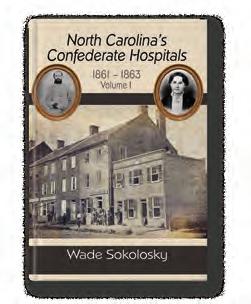
Vol. I
By Wade Sokolosky Fox Run Publishing, 2022, $19.95.
Early in the war, the Confederate government had sought centralized control of the medical system, only to butt heads with states believing in a literal interpretation of “states’ rights.” North Carolina, one of those with its own medical system in place, resented outside interference in particular, frequently a significant problems in the acquisition of resources and in building and administering hospitals. For those running the hospitals, this could cause confusion, as guidance often came from different sources.
A number of hospitals were built along rail lines, advantageous in the movement of wounded soldiers from forward areas to more permanent locales in the rear. These would become known as “Wayside” hospitals.
One problem the Confederates faced that their counterparts in the North didn’t was the threat of capture or destruction by invading forces. When Union forces along the coast struck inland, they usually remained oriented along rail lines, which inevitably put the medical facilities near the rails in danger. Several threatened hospitals, in fact, were forced to pick up and move quickly. The sudden displacement, of course, created problems for hospital staff and administrators scrambling to find suit-
The maps in Sokolosky’s book provide a welcome perspective on the location of the hospitals, and a number of nice images are included of key administrators and some of the hospitals themselves. One intriguing appendix examines the loss of a major hospital due to arson; another deals with a chain of correspondence involving a senior Confederate administrator. As we see, not everyone trying to make this an effective process proved to be a “team player.” Personal feuds were a constant problem for administrators and commanders, as was the refusal by some civilians to lease their buildings and property to the “Cause.”
I especially enjoyed the choice “nuggets” Sokolosky spreads throughout his narrative, rare material and factoids that surely will surprise even the most ardent Civil War buff.
In his latest effort, Sokolosky greatly expands our knowledge of the innovative, yet disparate, medical care Southern soldiers received during the war—how key problems often were solved due to the initiative and creativity of individuals facing a large-scale war for the first time. For those captivated by the complexities of war “behind the lines,” I can’t recommend this enough. Edward Kennedy
THE FUTURE OF the Trans-Mississippi West was, to a large extent, at the heart of the Civil War—with the issue of whether freedom or slavery would thrive beyond the Mighty Mississippi with either side’s victory very much at stake. In a 1974 dissertation by William Royston Geise, finally brought to print here with editor Michael J. Forsyth’s assistance, Geise offers a fascinating, well-researched case study in which the focus is less on military operations than the administrative challenges military authorities in that region confronted during the war.
These authorities indeed had a very full plate with which to deal. What was known by the end of the war as “Kirby Smithdom” included three states and the Indian Territory, all with their own internal dynamics and distinct perspectives on matters that the principle of states’ rights ensured would demand attention. Furthermore, there were the problems of Missouri’s government-in-exile; the border with Mexico as that nation wrestled with internal turmoil; New Mexico Territory; and having to defend an extensive stretch of the Gulf Coast with little in the way of naval resources. It didn’t help either that Richmond often used the TransMississippi as a dumping ground for commanders who had struggled elsewhere.
By
in Command
The Confederate Military Forces in the Trans-Mississippi West, 1861-1865: A Study

William Royston Geise (Michael J. Forsyth, editor)
Savas Beatie, 2022, $32.95
Efforts to deal with all of these problems—and countless issues usually considered the province of civil authorities (e.g., the cotton trade)—are clearly and thoroughly chronicled in Geise’s solidly constructed study. Of course, in the nearly five decades since it was completed, the Trans-Mississippi West and its role in the war can hardly be said to have been forgotten or neglected by scholars of the Civil War. Nevertheless, Geise’s study is a useful and interesting addition to the impressive body of recent scholarship examining events in the region. —Ethan S. Rafuse

SPRING 2023 63
REVIEWS
ACWP-230400-REVIEWS.indd 63 12/12/22 12:28 PM
COLONEL
Percy Wyndham
On January 25, 1879, a crowd estimated in the thousands packed inside Dalhousie Park in the Burmese city of Rangoon to experience what was promised to be a resplendent event— Percy Wyndham’s ascent in a hot-air balloon that the dashing, former Civil War colonel had personally constructed. What they witnessed instead was pure horror.
The son of a British cavalry captain—born in 1833 aboard HMS Arab en route to Calcutta—Wyndham undoubtedly had always been a showman. His time in the Union Army, which followed stints in several European nations’ militaries, would be relatively brief. After spending time as a midshipman in the French Navy, he served for eight years as a second lieutenant in the Austrian Army. In 1860, he joined Italian revolutionary Giuseppe Garibaldi’s “Redshirts” in Italy—made a chevalier of the Military Order of Savoy by King Victor Emmanuel II of Sardinia for his distinguished service. A year later, he traveled to America to offer his services to the U.S. government.
Audacious
Percy Wyndham’s “characteristic death closed a career more chequered than falls the lot of many,” wrote one newspaper after he was killed.
In February 1862, New Jersey Governor Charles S. Olden appointed Wyndham colonel of the 1st New Jersey Cavalry. During the Battle of Good’s Farm (Va.), on June 6, 1862, Wyndham fell into Confederate hands after his horse was shot beneath him during a charge. While in captivity, Wyndham would be recognized and embraced by an old comrade, Confederate Major Chatham Roberdeau Wheat, who had served with him during Garibaldi’s campaigns in Italy.

Paroled in August, Wyndham returned to his cavalry brigade. At the June 9, 1863, Battle of Brandy Station, he was severely wounded in the right leg, and sidelined for the upcoming Battle of Gettysburg.
In September 1863, Maj. Gen. Joseph Hooker recom-
mended Wyndham for promotion to brigadier general; however, Secretary of War Edwin M. Stanton suspected that the soldier of fortune was plotting against the U.S. government and banished him from the Army. The accusation was never substantiated, but in July 1864, Wyndham mustered out of the Army, having never received his promotion.
He opened a fencing school in New York City, but returned to Italy when war broke out there in 1866, and then headed to Calcutta, where in 1872 he started the satirical magazine The Indian Charivari. A victim, however, of some poor investments, he eventually faced financial ruin and moved on to Burma.
It was there in Rangoon, on that January day in 1879, that Wyndham would be killed. The well-publicized balloon ascent was a promising financial venture, as individuals, for a small fee, were welcome to tour the 70-foot-tall contraption he had built.
On his first attempt, Wyndham was reportedly 500 feet in the air when the balloon burst apart, sending him crashing into a lake below. Wyndham’s body was pulled from the debris, and two doctors from the crowd attempted unsuccessfully to resuscitate him. Bleeding from the nose and mouth, with a fractured skull, Wyndham likely had already been asphyxiated to death by the burning straw and oil before even hitting the water—no one was sure.
On February 9, 1879, Wyndham’s remains were placed in a coffin of polished teak, with gilt mounts, and interred in what is now an unmarked grave in Rangoon’s town cemetery. Shrouded Veterans is working with the British Association for Cemeteries in South Asia (BACSA) and the U.S. Embassy in Rangoon to locate his gravesite.
Frank Jastrzembski
64 AMERICA’S CIVIL WAR
LIBRARY OF CONGRESS
FINAL BIVOUAC
Final Bivouac is published in partnership with “Shrouded Veterans,” a nonprofit mission run by Frank Jastrzembski to identify or repair the graves of Mexican War and Civil War veterans (facebook.com/shroudedvetgraves).
ACWP-230400-BIVOUAC.indd 64 12/12/22 9:21 AM




HOME
VISIT FISHERHOUSE.ORG FREE LODGING | HERO MILES | HOTEL FOR HEROES ACWP-230117-001 SMG Trade Page.indd 1 12/11/22 3:51 PM
A HOME AWAY FROM
On any given night, up to 1,300 service members, veterans, and their families can call Fisher House home. These comfort homes are free of charge while a loved one is receiving care at military and VA hospitals. ALL VETERANS. ALL ERAS. For Service members, Veterans, and their families.









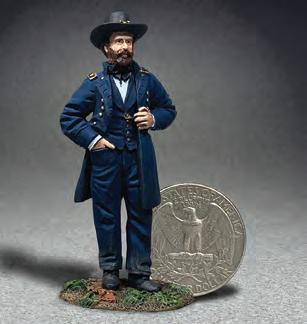






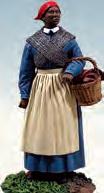








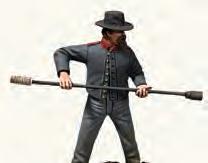













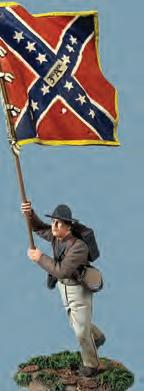








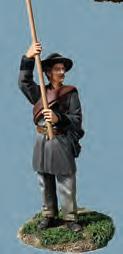






























WBHN-ACW 08-27-2022 ©2022 W.Britain Model Figures W.Britain, and are registered trademarks of the W.Britain Model Figures, Chillicothe, OH Follow us on Facebook: W-Britain-Toy-SoldierModel-Figure-Company Subscribe to us on YouTube: W.Britain Model Figures See these and more W.Britain 1/30 scale historical metal figures at: Tel: U.S. 740-702-1803 • wbritain.com • Tel: U.K. (0)800 086 9123 Our 1/30 scale metal figures are painstakingly researched for historical accuracy and detail. The originals are hand sculpted by our talented artists before being cast in metal and hand painted – making each figure a gem of hand-crafted history. Please visit wbritain. com to see all these figures and more from many other historical eras. Call W.Britain and mention thisad for a FREE CATALOG Also receive a MINI BACKDROP with your first purchase! matte finish Hand-Painted Pewter Figures 56/58 mm-1/30 Scale 10094 Union General U.S. Grant $46.00 31261 Confederate Infantry Texas Brigade Advancing, No.2 $42.00 31334 Confederate Casualty Falling $42.00 Advancing 31116 Confederate General “Stonewall” Jackson Mounted on Little Sorrel $110.00 10085 Frederick Douglass American Abolitionist and Social Reformer $45.00 10095 Colonel Robert Gould Shaw, 54th Massachusetts $48.00 10088 Harriet Tubman American Abolitionist $46.00 10086 Sergeant Major Lewis Douglass, 54th Massachusetts $45.00 uglass,Do 31313 Sending Mischief Down Range Federal Artillery Firing 10-Pound Parrott Gun $180.00 31395 Give ’Em Canister! Confederate 12 Pound Napoleon and Crew $200.00 31380 Confederate Infantry Bugler, $46.00 10096 Sgt. William Carney, Flagbearer, 54th Massachusetts $58.00 Confederate Flagbearer, 1st Texas Flag, Wigfall Pattern, Texas Brigade 31394 Confederate Flagbearer, 3rd Arkansas Flag, Texas Brigade $58.00 31389 Confederate Flagbearer, 5th Texas Flag, Texas Brigade $58.00 Confederate Infantry Waving ANV Flag ACWP-230117-002 WBritian Model Figures.indd 1 12/12/22 3:03 PM





























































































































































































 By Bruce Allardice
By Bruce Allardice












 By Sheritta Bitikofer
By Sheritta Bitikofer
























 By Stephen Davis
By Stephen Davis



































 By Ernest A. Dollar Jr. Savas Beatie,
By Ernest A. Dollar Jr. Savas Beatie,

 David Marshall
David Marshall
 By Richard F. Miller University Press of New England, 2005
By Richard F. Miller University Press of New England, 2005
















































